 United Kingdom: 4 aircraft carriers:
United Kingdom: 4 aircraft carriers:HMS Albion, Centaur, Bulwark, Hermes, 4 more cancelled
British Cold War Carriers:
Majestic class | Centaur class | HMS Victorious | HMS Eagle | HMS Ark Royal | HMS Hermes | CVA-01 project | Invincible class | HMS Argus | Queen Elisabeth class (planned)The first postwar British aircraft carriers
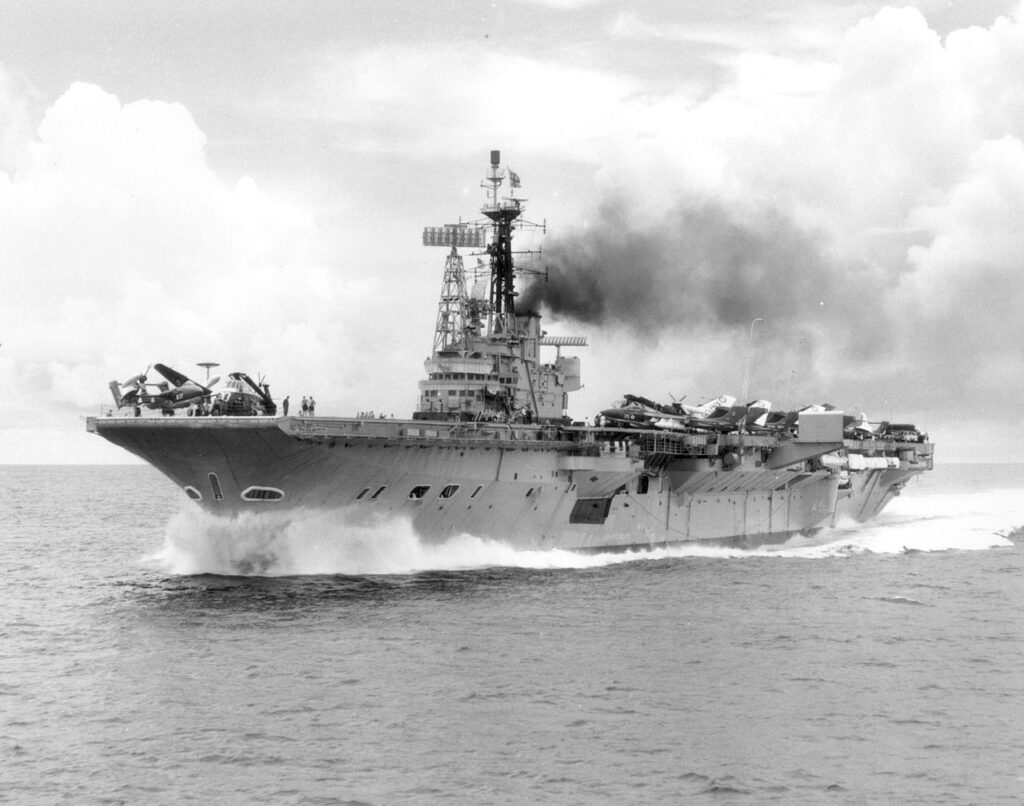
First British cold war carriers, last started in WW2, the Centaur class were part of the 1942 Light Fleet Carrier program, later modified to include eight “intermediary fleet carriers” in 1943: HMS Albion, Centaur, Bulwark, HMS Hermes (i) and later (ii), Monmouth and Polyphemus, later cancelled. Third of the 1942 light fleet aircraft carriers program after the Colossus class (10 ships) and Majestic class (6 ships), the centaur group were designed in 1943 as an enlargement of the Colossus, from 13,200 tonnes to 18,300 tonnes and 734 ft (224 m) long instead of 692 ft (211 m), like an intermediary to the Illustrious/Implacable classes. They were tailored for future larger aircraft and were indeed a more useful base for modernization, explaining why they were retained by the Royal Navy and not sold abroad like previous ships. Of all, HMS Hermes(ii) had the longest career, retired only in 1986 after acquiring fame in the Falklands War, and retained by India as Viraat until 2021. #ww2 #centauclass #royalnavy #coldwar #hmscentaur #hmsalbion #hmshermes #hmsbulwark #aircraftcarrier
Design of the centaur class
Development
The Royal Navy hoped to order eight light fleet carriers in 1943, to supplement the much larger Malta-class fleet aircraft carrier. However at the time, aicraft technology was progressing fast. Drastic wartime speed and payload specifications imposed larger aircraft, with greater approach speeds. This demand to operate larger and higher performing aircraft already existed by the end of 1942 and was discussed by the Joint Technical Committee, which recommended a new 30,000 pounds (14,000 kg) working standard with a landing speed of 75 knots (139 km/h). The earlier light carrier designs of the Majestic-class were already too advanced to be modified without significant delays to handle these new requirements. So not to disturb these urgently needed carriers, it was decided to postpone this new set of requirement and work on a new, tailored design. A sketch design was prepared by the end of May 1943, and the final design was approved in March 1944, but revised again in 1947 with the advent of jet aircraft. In between the war ended.
The modifications did not started on a blank page. The essentials of the last 1942 design were kept, but the hull was increased in size, to keep the same hangar capacity, the deck was reinforced as were the lifts, and a new catapult was on the works as well as a new landing signal system.
Construction
Eight of these new light “intermediary fleet carriers” were ordered in 1943. But wartime demands were already taxiing on shipyards in Britain, and it was obvious to anyone that this made impossible a completion before 1946 at the earnest. Three carriers, HMS Albion, Centaur, Elephant were laid down by 1944, respectively at Harland & Wolff, Belfast on 30.5.1944, at Swan Hunter, Wallsend on 23.3.1944 and at Vickers-Armstrong, Barrow on 21.6.1944. Elephant was laid down previously as HMS Leviathan. This was changed again for Hermes postwar.
HMS Bulwark was started at Harland & Wolff, Belfast right after Albion, laid down on 10.5.1945. The remainder were HMS Arrogant planned at Swan Hunter, Wallsend, Hermes planned at Cammell Laird, Birkenhead, Monmouth at Fairfield, Govan and Polyphemus at Devonport DYd. With the war over, they were cancelled on 15 October 1945 without being laid down. The remainder saw their construction suspended also on V-Day, like the previous Majestic class, giving time to the government and admiralty to decide their fate. They were completed in the 1950s eventually after a last design revision in 1947 to operate jets.
Post-war modernization
Budget-restrictions in post-war Britain had an immediate impact on the ship’s modernization, making in the end compromises and creating divergence in capabilities even before completion:
-HMS Albion and Bulwark had the early, “interim angled flight deck” and new hydraulic catapults but were not modernized to operate modern aircraft and converted into helicopter assault ships or “commando carriers”.
-HMS Centaur was partially modernized, having new steam catapults before commission but could only operate the De Havilland Sea Vixen until 1965.
-HMS Hermes was the last completed in 1959 and this delayed allowed to attempt a full-blow modernization, so much so most sources, including Conways, separates her entirely. She became her own class. She operated Sea Vixens and Blackburn Buccaneers until 1970, then became an helicopter carrier (she ws decidedly too small for the F-4 phantom and new generation jets), and later was converted again as a V/STOL carrier to operate the new Sea Harrier fighters. Hermes soldiered famously in the Falklands, ensuring the success of the whole campaign, and was sold to India as INS Viraat, still operating Indian Sea Harriers until 2017.
Design
The 1942 light fleet carrier were originally a wartime expedient, a much simplified, unarmed fast carrier that can be mass-produced and answered the needs of the RN to complete its mission in the Mediterranean, Atlantic and later in the Pacific. The design recalled on the surface the Illustrious/Implacable classes, but without protection and extremely simplified again, so much so their cost was halved as well as construction time. The hull was even built to merchant standards to better fit some Yard’s experience. Armament was limited to light AA guns, existing cruiser machinery was chosen for its reliability, at the cost of some speed loss. Discussions leading to the design clearly made them “expandable”, with a planned durability of just three years of service. The irony was their impressive cold war service for some, after several modernizations in foreign navies.
Original design (1943/44)

Original blueprint, HMS Centaur 1947
The Centaur class were different, as in the initial 1943 sketches, they were already designed for a longer post-war career, and greater care was put into the design. They were already hybrid of merchant and warship standards, notably due to the confidence given to British Yards’s experience at that stage. Protection notably, made a return: There was armour on a reinforced flight deck, there were well-designed longtitudinal protective bulkheads and armor on the middle deck over the machinery, as well as on lower decks and over the aviation fuel tanks, all made with the latest hardened steel on offer. Magazines and bomb storage areas were covered by 2-inch (40 mm) non-cemented armour (NCA). The remainder was made of mild steel in a now well understood “all or nothing” approach.
The hull was also enlarged for larger aircraft with 1-inch of hardened steel over the initial flight deck to supported these new heavier aircraft. At that stage, this was still an axial flight deck, but it included a new steam catapult The machinery was not impressive however, still compromised. It represented half the set used on the Audacious-class for an output of 76,000 shaft horsepower, still on two shafts and very limited capacity of upgrades. As a result, top speed was limited to 29.5 knots instead of 33, and even fell to 28 after postwar completion. Armament was however changed and increased compared to the 1942 program carriers, with four twin 4.5-inch dual purpose guns, same as the fleet carriers, and clear improvement.
Postwar revised design (1947)
The design was modified postwar, notably by taking in accounts numerous reports of service. Living arrangements were upgraded to peacetime standards for exampke, including centralized messing for practicality, and the aft hangar was even converted into additional living space. A second catapult was added but required a revision of the hangar length which went from 501 feet (153 m) to 381 feet. The 4.5 inch guns were removed to make more space and now pretty useless against jets. The island was also redesigned, reinforced to receive new derrick masts and heavier radars. It had notably a new “two-deck” configuration for better information organization. The originally intended radar suite comprised initially an air warning Type 980 radar, a gunnery air search Type 293 radar and two pairs of air control Type 277Q fire control radar, but this was modified later.
Hull and general design
Displacement and Dimensions
Original figures in 1943 were 18,310 tons standard, 24,000 full load, they were revised in 1947 to 22,000 tons standard (a 4,000 tonnes increase !) and 27,000 fully loaded, same as an Illustrious class’s standard displacement.
As for dimensions, initially this was 198.1 meters between perpendiculars and 224.6 meters overall, and this was ported to 224.8 meters overall after 1947 or 736 ft (224.3 m depending on the source). Hermes was even larger (see later). In beam, they stayed at 27.4 m at the waterline (90 feet) but the final deck width became 37.5 meters (123 feet) overall or 36.8 m (120.6 ft) depending on the ships, Albion, Bulwark or Centaur.
The draft augmented considerably after the 1947 design revisions as well. Originally of 7.52 m (24 feets and a half) deep load, it went to 8.20 meters (27 feet) or 8.30 meters (27.2 ft) depending on the ship.
The general design was still reminiscent of the previous 1942 light fleet program carriers in outlook, but much reinforced, and with a new island.
A variable crew
The ships carried variable crew, with considerable differences during their long service, configuration and missions. In 1943 as planned, this was 227 officers and 1,596 ratings not including the air group personal. This was considerable. To compare, a Colossus class had 1,050 men in all, officers and rating included. Logically, the ships would have a smaller air group personal due to less aircraft aboard, but maintenance was no less intensive. The 1947 design revision which scrapped the dual purpose battery also spared extra personal, as later reduction in AA artillery. But what was lost in defensive armament was regained in combat information management and sensors, more complex with extra operators. Later it was even increased when command facilities were added, in the new task group organisation. Complement on the first three carriers was circa 1400 when completed, and 2100 on HMS Hermes.
Armour protection layout
It was defined in 1943 and remained unchanged for the three early carriers after the 1947 redesign, and also on HMS Hermes after completion:
-Inner belt: 25 mm or 1-inch
-Flight deck: 19 mm or 0.74 in.
-Box protection over the magazines: 51 mm (2 inches)
-Glacis over the machinery spaced of 25 mm (1 inch)
Albeit this was a real improvement over the Colossus/Majestic classes, the choice of an inner belt to covered the machinery only, very limiuted underwater protection and partial glacis did not ensured survival after a torpedo hit, only by virtue of machinery space separation, and compartimentation. Centaur, Albion and Bulwark as well as Hermes all had the same relatively poor protection compared to the fleet carriers. It was almost tested in the Falklands for HMS Hermes as the Argentinians had modern type 209 submarines.
Powerplant
Originally the 1943 design included two sets of Parsons geared steam turbines and four Admiralty 3-drum boilers for a total output of 76,000 shp. After 1947, the boilers were changed for a more efficient type, and the output was raised to 78,000 shp. It stayed however the same for Hermes. Top speed initially planned was 29.5 knots (52.8 km/h; 32.8 mph) but after the 1947 revision and despite output increase, it fell to 28 knots (51 kph, 32 mph), about the same for Hermes at first.
For autonomy, the carriers carried originally 4,000 tons of oil. However 1947 peacetime revisions emphasis habitability, and space was reclaimed on the fuel tanks, which went down to 3,880 tons. Design revision on HMS Hermse however inverted the tendency as she could hold 4,200 tonnes of oil, for an Endurance of 6,000 nautical miles or even 6,900 nm at 20 knots cruise speed initially, but 10,000 for the 1947 revised ships. This was notably due to enriched oil standards and far more efficient boilers.
Armament
Sextuple Mark IV 40mm/56 RP10
As said above it was considerably revised. As seen below, the 20 mm were gone, general trust of the allies for the Bofors was well established, and in 1943, these carriers had a total of 32 tubes, complementing the main turrets with two of the brand new (planned) sextuple 40 mm/56 turrets. To make room and decrease top weight, AA artillery was reduced in 1947, not in tubes, still 32, with less twin mounts complemented by single ones. The sextuple mounts were kept. HMS Hermes was the most revised, with the sextuple mounts removed and just left with five twin 40mm/60 Mk 5.
⚙ Armament: |
|
| 1943 | 4×2 4.5in(114mm)/45 RP.10 Mk IIBD, 2×6 40mm/56 RP.10 Mk I, 11×2 40mm/56 STAAG |
| 1947 | 2×6 40mm/60 Mk 6, 8×2 40mm/60 Mk 5, 4x 40mm/60 Mk 7 |
| Hermes 1959 | 5×2 40mm/60 Mk 5 |
Armament Revisions
There were further revisions over time: In 1956, Centaur, Albion, Bulwark had six single 40mm/60 removed.
During her 1960 OVL at Devonport DYd, HMS Bulwark was converted to a “commando carrier” (LPH) and her two sextuple 40mm/60 mounts, four twin 40mm/60, four single 40mm/60 were removed.
During her 1961-1962 refit at Devonport DYd Albion followed the same path and she had her two sextuple 40mmm/60, four twin 40mm/60, four single 40mm/60 removed as well. This left both with four twin Bofors only.
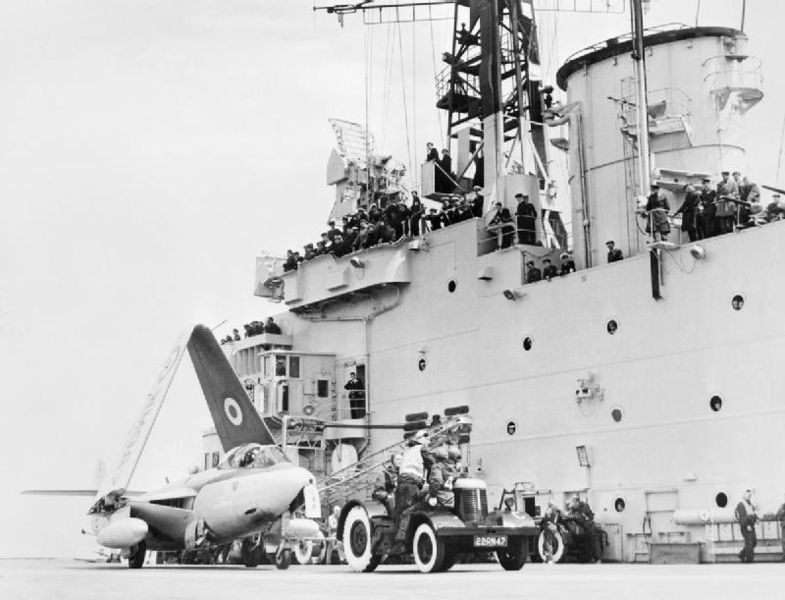
Detail of the large island of HMS Centaur in 1955. A Hawker SeaHawk from NAS 803 just landed is towed back to the lift.
Sensors
Orignally they came in 1943 with a set that was never installed:
-Type 980 air warning radar
-Type 293 gunnery air search radar
-Four Type 277Q air control radar FCS
Post-1947, Centaur, Albion, and Bulwark came out with the following:
Type 262 radar:
Type 262 is operating in the X-Band as a naval fire control radar, for 40 mm anti-aircraft Bofors guns, and later Sea Cat close-range surface-to-air missiles, developed in 1958.
Its antenna is for conical scan, with fixed feeding point, slightly eccentric rotating parabolic reflector.
Type 982 radar: The Type 983 height finder was generally paired with Type 982 for direction.
Type 983 radar: Type 983 operated in S-Band and was a quite accurate height finding radar usable also for providing surface and low air warning. The type AQT 7 tons antenna had a reflector 14 ft 6″ in height by 5 ft wide. Its turn table was triaxially stabilized, to 6 minutes of arc. It was specific to the Centaur-class aircraft carriers.
Type 275 radar: Coupled with a telemeter, the type 275 is operating in the F-Band. Its a common FCS radar seen on Cruisers and aircraft carriers. It had a separate Transmitter and receiver antennas in two nacelles mounted on the director tower, air conditioned, Conical Scan yupe to provide accurate range, bearing and elevation data.
Type 974 radar: An X-band radar for maritime reconnaissance and navigation, modified version of the Decca Type 12 civilian radar. It had an AKL type antenna with separate transmitting/receiving antennas, turntable with motor drive, and modulator, transmitter and HF modules.
Sensors Revisions:
In 1960 Bulwark received six type 262 radars. In 1966 Hermes received two type 903 radars, in 1973 a Type 965 radar, and no more additions until decommission in 1986.
⚙ Sensors |
|
| HMS Centaur | Types 960/965(AW) 982(2 sets) 983 978 293. |
| HMS Albion | Types 960/965(AW) 982(2 sets) 983 978 293 |
| HMS Bulwark 1960 | Types 262, 982, 983, 275, 974 |
| HMS Hermes 1959 | Type 984, 982, 5x type 262, type 974 |
⚙ Centaur (first three) specifications as designed |
|
| Displacement | 22,471 tons standard, 27,015 tons DL |
| Dimensions | 736 x 120.6 x 27.2 ft (224.3 x 36.8 x 8.3 m) |
| Propulsion | 2 shaft geared steam turbines, 4 Admiralty 3-drum boilers, 76,000 hp (57,000 kW) |
| Speed | 28.5 knots (52.8 km/h; 32.8 mph) |
| Range | 6,000 nautical miles (11,000 km; 6,900 mi) at 20 kn |
| Armament | 32x 40 mm Bofors guns, see noted |
| Protection | 1 in (25 mm) flight deck, see notes |
| Sensors | Type 980 air warning radar, Type 293 gunnery air search radar, 4x Type 277Q air control radar |
| Crew | 227 officers, 1596 ratings, see notes |
| Air Group | 50 (1943), see notes |
| Facilities | 2 lifts, 2x BH V hydraulic catapults, Mk 11 arrestor gear |
The case of HMS Hermes (ex-Elephant)
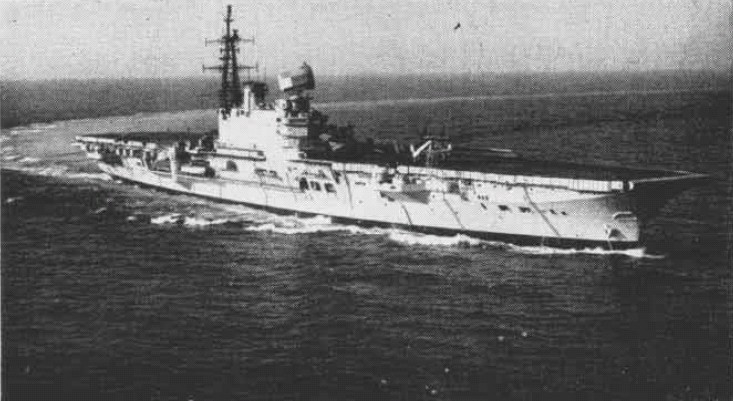
HMS Hermes (R12) in 1962
HMS Elephant was ordered from Vickers-Armstrong, on 12 July 1943, laid down at Barrow-in-Furness on 21 June 1944, renamed as Hermes on 5 November 1945, Construction suspended due to world reaffection on the higher-priority HMAS Melbourne (R21) paid by Australia.
This enabled also major design revisions. Thus, she was launched in 1953 and entered a full modernization phase requiring partial disassembly, reconstruction of 80% internal spaces. She obtained new modern paired steam catapults forward, the latest full 8° angled flight deck, side lift, new accomodations, new electic generation systems, revised powerplant, more oil bunkerage, new sensors, rebuilt island, comprehensive Display System (CDS), the Type 984 radar. She made her trials on 18 November 1959, commissioned on 25 November.
In 1964-1966 she saw the removal of five twin 40mm/60 (last)and of her type 262 radars for the addition of four quadruple Sea Cat GWS22 SAM (only carrier in the class with missile defence), and to provide them data, two type 903 FCS radars. Despite her modern capabilities, the size of fleet carrier force was reduced and nature of warfare and new defence policies pushed Hermes to conversion as helicopter assault ship at Portsmouth until August 1973. She had her steam catapults, arrestor gear, CDS, Type 984 radar removed. But she received a type 965 radar and was refitted to carry up to 18 Wessex helicopers.
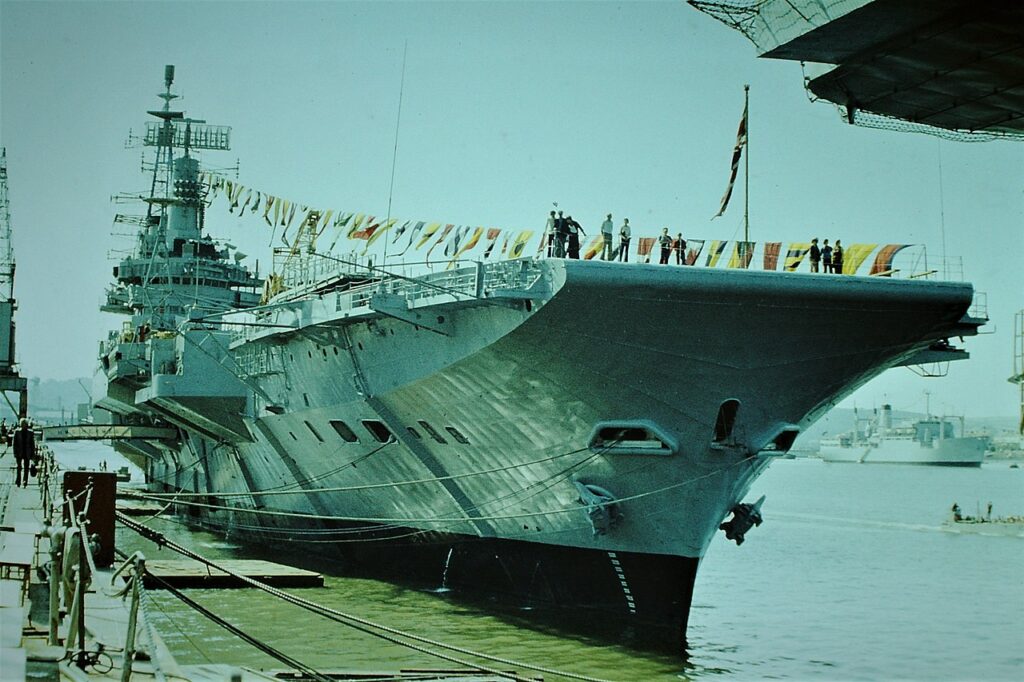
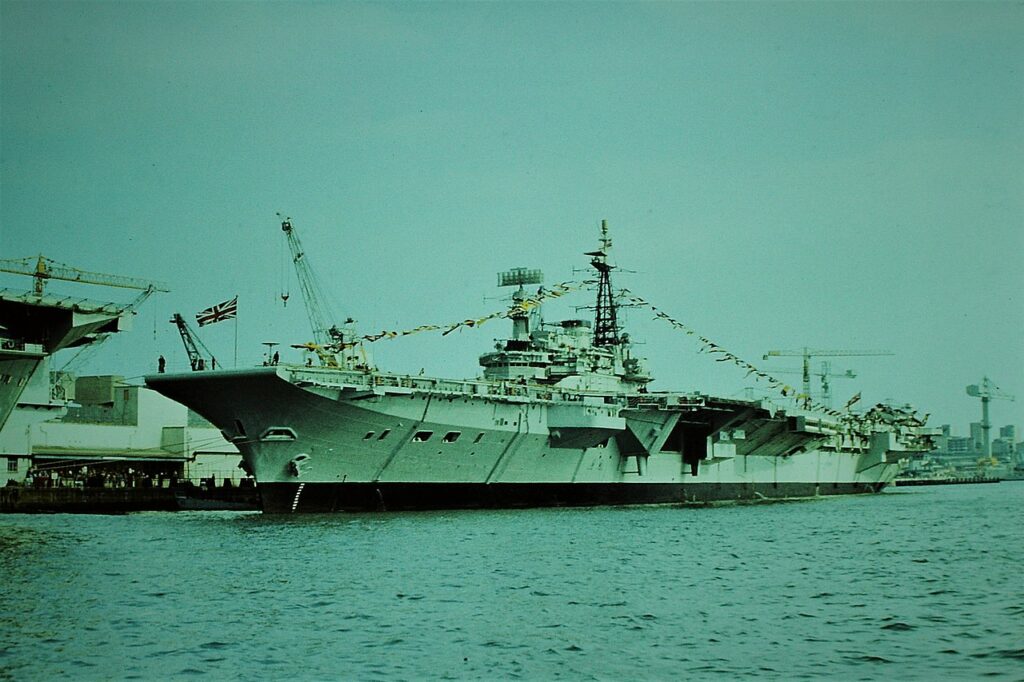
HMS Hermes berthed at Plymouth after her last refit in August 1977
Lastly, she was refitted again as an ASW carrier in May-December 1976. This mostly consisted in adaptation to a more intensive ASW storage, depht charge, buoys, acoustic torpedoes, new suite to better communicated with ASW specialized ships and frigates, and the hangar refitted to carry Sea King ASW helicopters.
She was again rebuilt as VTOL carrier, meaning capable of operating the Sea Harrier VTOL jet which appeared in 1977-1978. Reconstuction was even more radical and lasted from May 1980 to 9 May 1981 at Portsmouth. Not only her sea Harrier brough back a multipurpose capacity, but she kept and ASW capabilities thanks to her park of Sea Kings, and air assault helicopters. The greatest changes were the removal of the two forward catapults and instead was built 12-degree ski-jump partially occupying the port corner of the forward deck. She also had the best sensors of the time, a Ferranti 1600E computer installed and flagship facilities.
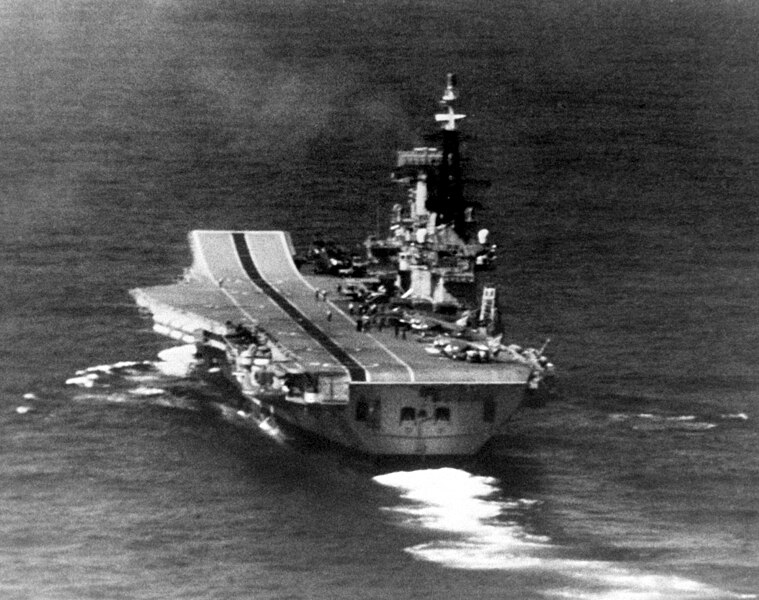
HMS Hermes at sea in 1982, stern view, showing well the forward ski jump
She became the centerprice of the British taskforce deployed by PM Margaret Thatcher during the Falklands War in 1982, one of the rare cases of British carrier-based action after the Korean war.
Hermes ws eventually paid-off on 22 November 1983, so soon after the war. Due to her capabilities, a considerable deal was made with India, so she was sold as is to India, when completion of HMS Ark Royal (R07) was secured. Before transfer she was refitted at Devonport for a year, recommissioned as INS Viraat on 12 May 1987, ensuring a stagerring thirty more years of service, decommissioned on 6 March 2017, scrapped 2020-2023. A new carrier recently completed is bearing the same name.
Between her laying down in 1944, no long after D-Day, and definitive retirement, she will have 79 years of existence, a record. This included 28 years (in reality 20 due to numerous reconstructions) and 30 under Indian flag, so close to half a century service.
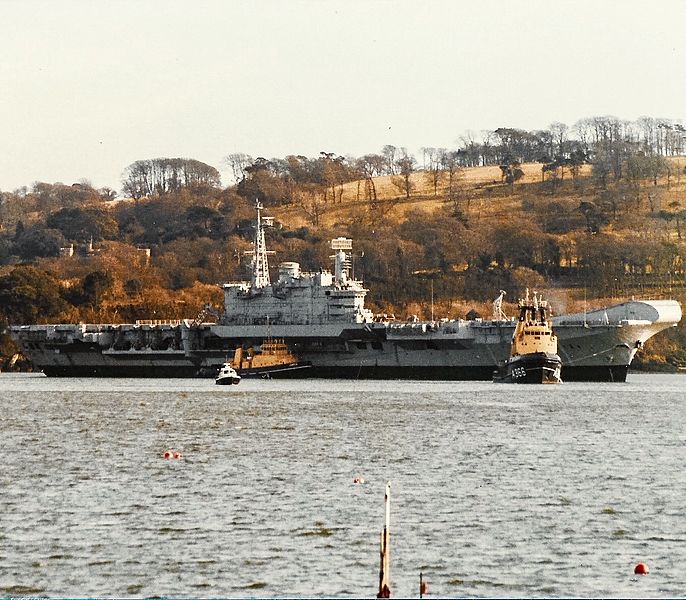
HMS Hermes coming around the corner in the Hamoaze on her way up the River Tamar 1986
⚙ Hermes 1960 pecifications |
|
| Displacement | 23,900 tons standard, 28,700 tons FL |
| Dimensions | 198.1 pp 226.9 oa x 27.4 wl 44.1 oa (48.8 oa since 1966) x 8.80 mean draft |
| Propulsion | Same as Centaur |
| Speed | Same as Centaur |
| Range | Oil 4200t, 10,000 nm/20 kts |
| Armament | 5×2 40mm/60 Bofors Mk 5, see notes |
| Sensors | Type 984, type 982, 5x type 262, type 974 radars |
| Crew | 2100, see notes |
Onboard Aviation & Facilities
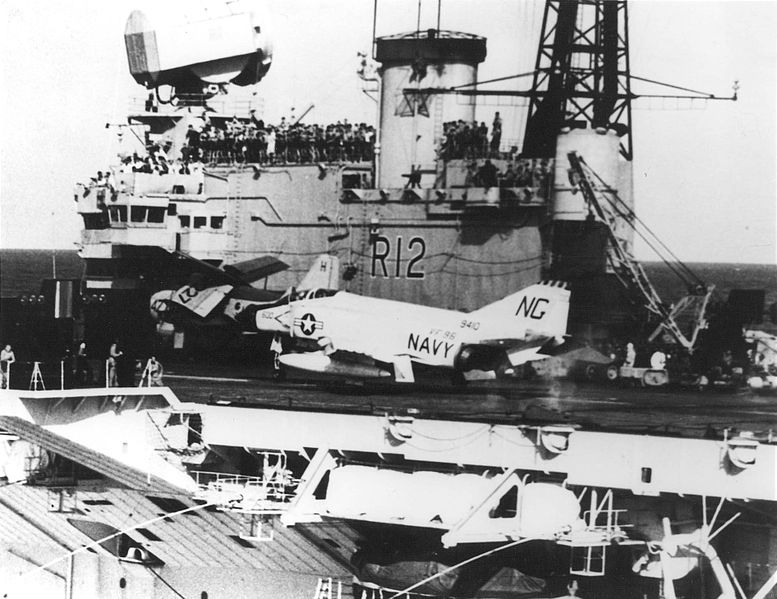
USN F4B of VF-96 aboard HMS Hermes, 1963. She was the only of the class capable of operating it.
In the 1943 original design, the Hangar was 5.3m (17-1/4 feet) in height, to the standards of the time. There were two lifts of 16.5 x 13.4 meters (54 x 49 feet) capable of supporting 15.9t ( Ibs). A single catapult BH-V (13.6t capacity, launched at 139 km/h) forward, off-axis. The early axial flight deck was marked by a broken white line running down the middle of the entire length of the flight deck.
Aircraft facilities were modified in 1947 according to new aircraft types on Centaur, Albion and Bulwark: The Hangar kept the same heighy, elevators were enchanged but with a second BHV catapult on the semi-angled deck (capacity 13.6t plane at 139km/h). HMS Centaur was revised to included the early type 5.5° angled flight deck, whereas on Bulwark and Albion it was angled to 5.75°.
The creation of the angled deck needed the cutting down the port sheerstrake,and having the walkways relocated, while removing three twin Bofors guns and directors for more space. Centaur became in effect the first angled-deck carrier in the Royal Navy, training in the English Channel in May-July 1954.
First air group comprised:
-9 Hawker Sea Hawk FGA6 of 806 NAS
-9 Hawker Sea Fury FB11 of 810 NAS
-6 Grumman Avenger AS anti-submarine aircraft, 820 NAS
-1 Westland Dragonfly HR5, ship’s SAR flight.
Catapults were replaced later by steam models B5-4 in 1956 (full specs unknown). Centaur had two BH5 30,000 lb (14,000 kg) hydraulic catapults at the bow, and six 30,000 lb (14,000 kg) arrestor wires. In the deck her two 35,000 lb (16,000 kg) capacity aircraft lifts were axial, 54 ft × 44 ft or 16 m × 13 m, identical forward and aft. Her hangar measured 329 by 62 by 17.5 ft (100.3 by 18.9 by 5.3 m). Avgas storage was 349,000 imp gal (1,590,000 L).
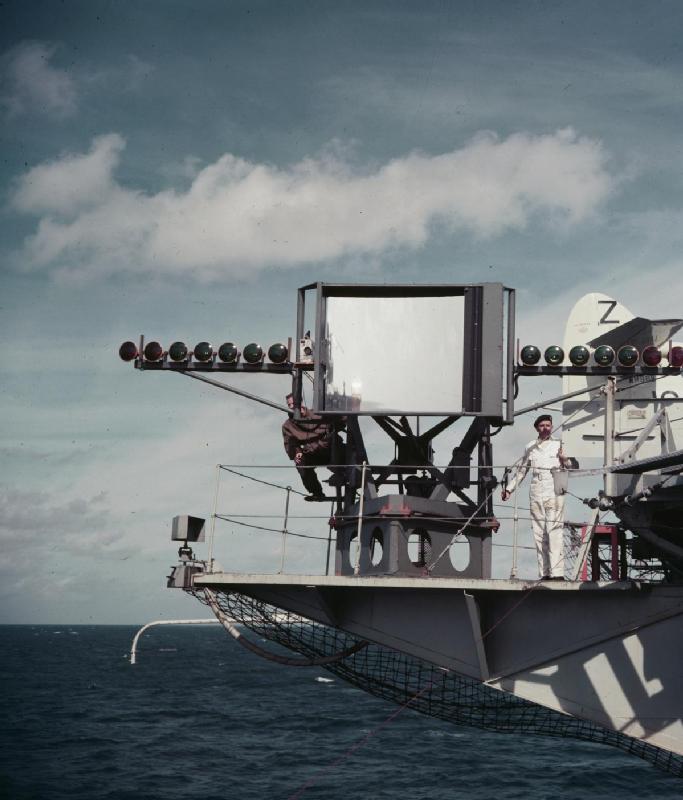
Landing mirror on HMS Albion, 1954
On HMS Hermes, this was revised considerably. Not only the flight deck was englarged and the angle deck more pronounced at 6.5°, but if the Hangar height was the same, she now had two lifts, with a fore deck edge lift measuring 16.5 x 10.7m (54 x 35 ft) supporting 15.9t aircraft, and an aft centerline lift same size as before at 16.5 x 13.4m and supporting 15.9t. She was also fitted from the start with two B5-4 catapults from the start. They were placed side to side forward, but too close to launch jets simultaneously. They were eliminated in 1981 and a ski jump ramp built instead (see later).
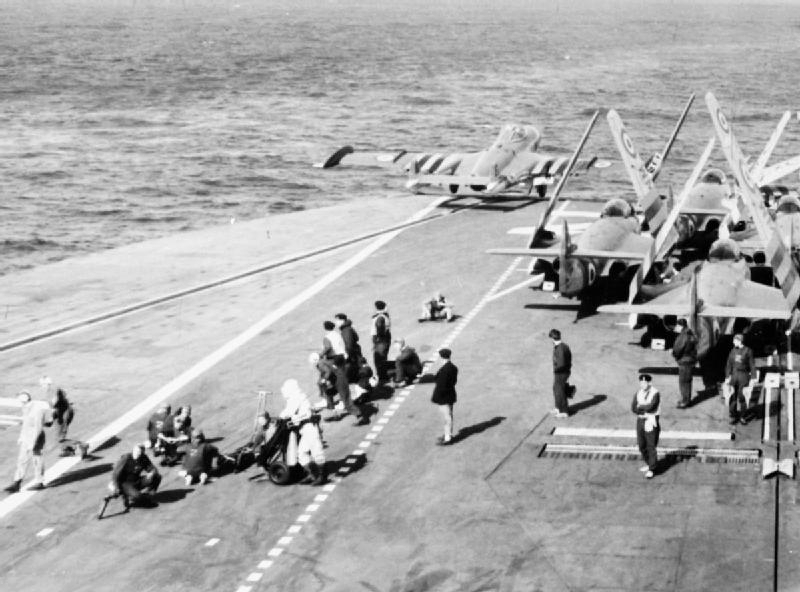
De Havilland sea venom from 809 NAS launched from HMS Albion, Operation Musketeer, Suez 1956.
Centaur class as planned (1943)
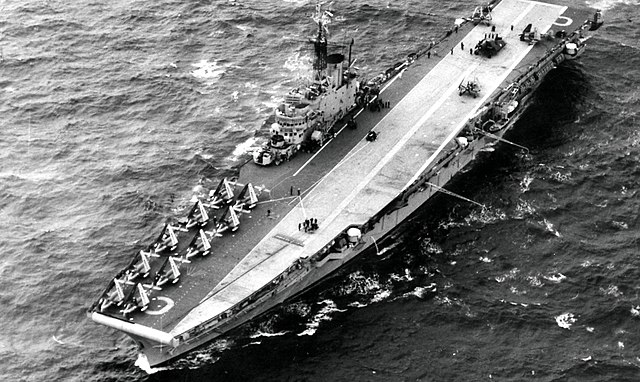
HMS Centaur in the Mediterranean, 1956
It was initially 50 aircraft as planned, with 42 aircraft carried in the hangar: Seafire, Firefly, Sea Hornet, Sea Fury fighters, Firebrand torpedo bombers, in unknown proportions, likely 12 strong squadrons following usual practice.
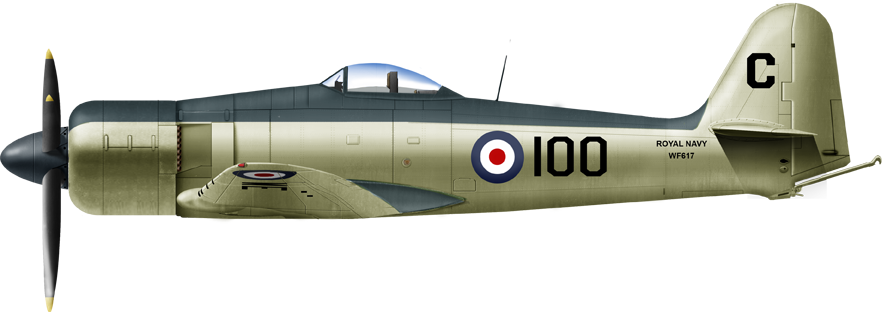
Sea Fury FB Mk.11 on HMS Centaur, 801 NAS, 1954
Centaur class as Revised and completed (1947-55)

26 aircraft only, still piston-engined Firefly, Sea Fury, Avenger ASW planes, but also De Havilland Attacker jets, Hawker Sea Hawk fighter jets, piston-engine Westland Wyvern attackers, and Skyraider early warning planes as well as a complement of Dragonfly helicopters.
Later for R08, the park included De Havilland Sea Venom fighters.
HMS Centaur during her short career operated the following:
806 sqn.: 8 Sea Hawk FGA6 Fighter-Attack
894 sqn.: 12 Sea Venom FAW21 Night/All Weather Fighter
849 sqn.: 4 Skyraider AEW1 Airborne Early Warning
815 sqn. 8 Whirlwind HAS7 Helicopter for Anti-Submarine Warfare
Ship Flight: Dragonfly HR5 Helicopter for Search and Rescue (SAR)
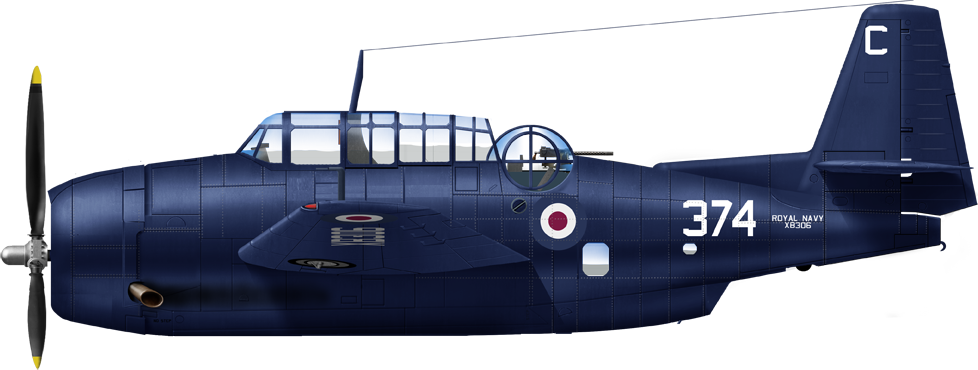
Grumman TBF AS4, 820 NAS HMS Centaur 1954
In the late 1950s, the reconstruction of several fleet carriers to port them to new aviation standards, left the Admiralty to resolve to have an interim carrier that can bridge the gap. At the time indeed, a Centaur class deck or lift was only specified to handle 30,000 lb (14,000 kg). But a fully loaded Sea Vixen FAW1 went to 35,000 lb (16,000 kg), a Scimitar to 34,200 lb (15,500 kg) which imposed them to the armed and fuelled on the flight deck, exposing them dangerously. A single Centaur-class with limited modernisation, would be targeted to reach minimum capability to operate these jets, and Centaur was selected for this in May 1956. She notably received two 139 ft (42 m) BS4 40,000 lb (18,000 kg) steam catapults forward, all Bofors guns removed, better air operations facilities and the new type 963 blind-landing radome on top of the island, extension on the port-side, 6° angled flight deck, and the arrestor cables upgraded during the 1960–1961 refit, all capable to handle 35,000 lb (16,000 kg).

Supermarine Attacker F.1, NAS 800 from HMS Eagle (not Centaur) 1952, serial WP493
After this, Centaur’s air group for January 1959 comprised:
801 Squadron: -14 Hawker Sea Hawk FGA6s fighter-bombers
891 Squadron: 8 Sea Venom FAW22s
845 Squadron: 8 Westland Whirlwind HS7s
D Flight 849 Squadron: 4 Douglas Skyraider AEW1s
Bulwark’s final fixed wing of 1957 comprised the following:
801 NAS: 8 Sea Hawk FGA6 fighter-attack
898 NAS: 8 Sea Hawk FGA6 fighter-attack
891 NAS: 8 Sea Venom FAW21 fighters
820 NAS: 6 Gannet AS4
849 NAS: 4 Skyraider AEW1
845 NAS: 5 Whirlwind HAS7 ASW helicopter
Ship’s Flight: Single Dragonfly HR5

Hawker SeaHawk FGA6, 800 NAS, HMS Centaur, c1959
It diverged considerably in operations however. HMS Centaur in 1954 for example sported only 25 aircrafts: 9 Sea Hawk FGA.6, 9 Sea Fury FB.11, 6 Avenger AS.4 and one Dragonfly HR.5 SAR helicopter. Apart the Sea Hawk, this was an all-piston engine, essentially late WW2 park.
On 1956 HMS Albion, she carried 12 Sea Venom FAW.21, 16 Sea Hawk FGA.6, but 4 Skyraider AEW.1 in replacement for the ASW Avengers, and same helicopter, so 33 aircraft, a peak.
HMS Centaur after overhaul in 1961 was now limited to 8 Scimitar F.1, 9 Sea Vixen FAW.1, 4 Gannet AEW.3 and 6 Whirlwind HAS.7 helicopters, a modern complement of 27 aircraft
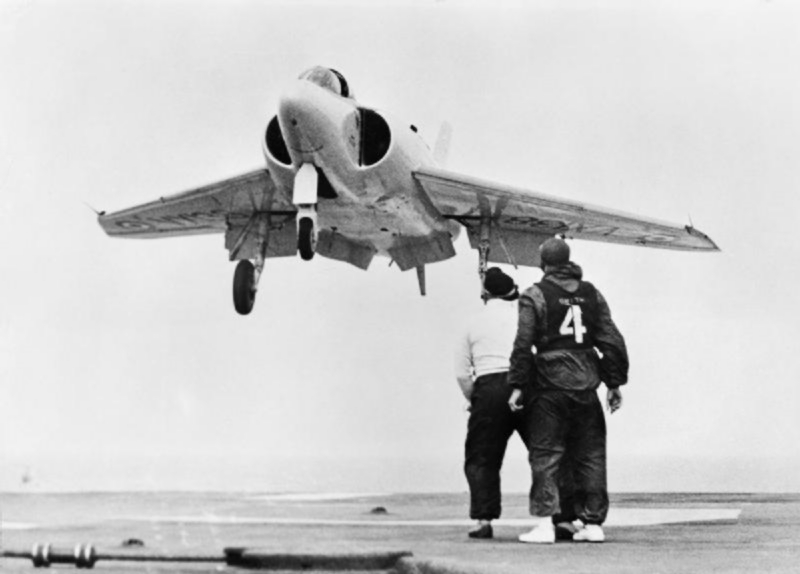

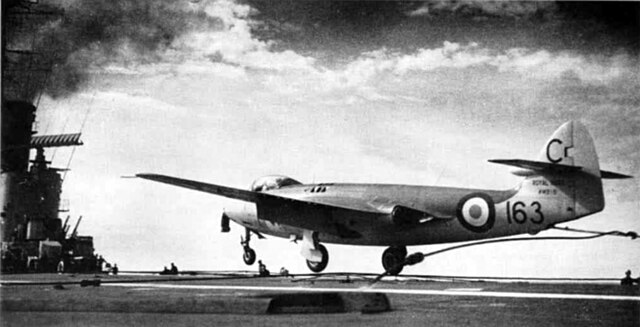
Air operations on HMS Centaur: Above: Supermarine 525 (Scimitar prototype) making her debut with Eric “Winkle” Brown in command. Below, Hawker Sea Hawk approaching to land on Centaur in 1956.
LPH (Commando Carrier) (1961)
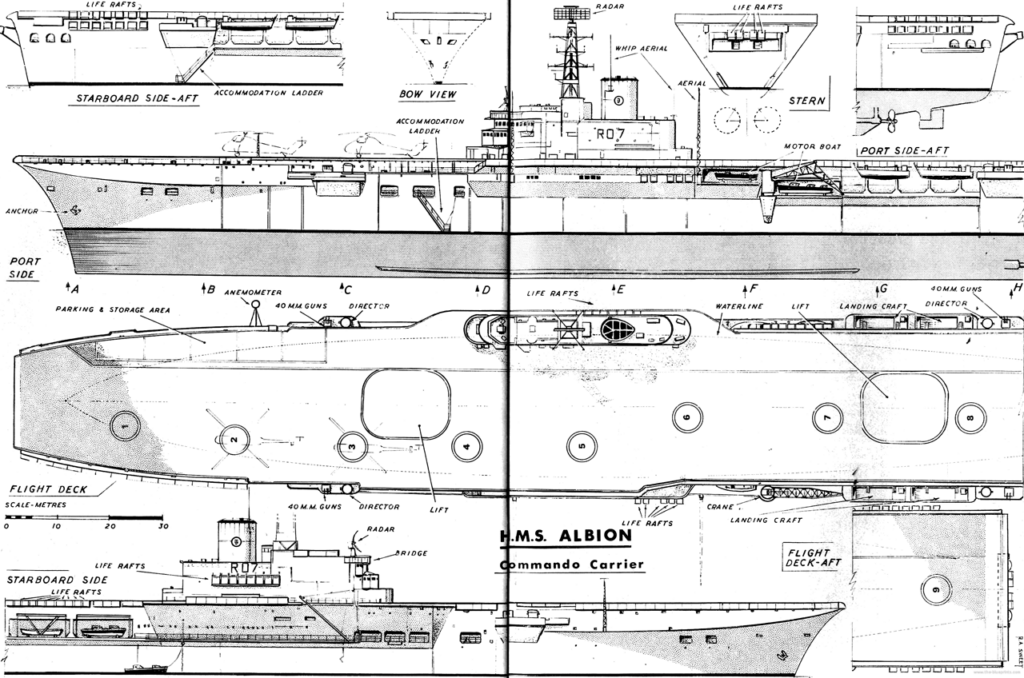
HMS Albion as Commando Carrier
Bulwark and Albion were modified to carry only eight, and later sixteen Wessex HU.5 in max capacity as well as a Wasp HAS.1 helicopter. Later it was upgraded to eight Whirlwind helicopters and later 16.
Hermes as completed (1959)
In 1959 she was planned to carry Sea Hawk, Sea Vixen, Scimitar fighters, Gannet ASW planes, Sea Venom, Gannet ECM planes, Skyraider, Gannet EW planes, and a single Dragonfly helicopters.
In 1966 she carried 12 Sea Vixen FAW.2, 7 Buccaneer S.1, 4 Gannet AEW.3, one Gannet COD.4 and 5 Wessex HAS.3 helicopter, so a comfortable park of 28 aircraft.
801 NAS: 7 Blackburn Buccaneer S.2
893 NAS: 12 de Havilland Sea Vixen FAW.2
849A NAS: 4 Fairey Gannet AEW.3, 1 Fairey Gannet COD.4
814 NAS: 5 Westland Wessex HAS.3 (ASW)
Ships Flight: 1 Westland Wessex HAS.1 (SAR)
Hermes in 1971 (Commando Carrier)

Author’s illustration of the Westland Wessex
This really was mission-oriented. She was modified and refitted to carry and operate Wessex helicopers, but numbers and complement (other SAR or plane guard models) changed. It was planned at first up to 18 Wessex or more but her troop carrier receded for a more NATO firendly ASW carrier. The height of the Wessex (15 ft 10 in (4.83 m)) barely fit inside the 5.3m (17-1/4 feet) hangar, with two feet to spare. It is not even sure she ever served long in that configuration.
Hermes in 1976 (ASW Carrier)

Author’s illustration of the Westland Sea King HMS Mark V
In 1977 she carried nine Sea King HAS.1, four Wessex HU.5 helicopters. Again, the larger size of the Sea King was an issue for the hangar. At 16 ft 10 in (5.13 m) she “scratched the roof” with a feet to spare. Eventually when acting as pure ASW carrier in the North Atlantic, she was fit to operate 20 Westland Sea King helicopters.
Hermes in 1981 (VSTOL Carrier)

With her sky jump she could be updated with the brand new sea harrier in 1980-81, carrying sixteen Sea Harrier FRS.1 multirole, and eighteen Sea King HAS.5 so 34 aircraft in all. Of course part of the park was permanently on deck. The Sea Harrier was 12 ft 2 in (3.71 m) tall and also barely fit inside the hangar.
Her first recommissioned air group was:
800 NAS: 5 Sea Harrier FRS.1 fighter
826 NAS: 12 Sea King HAS.5 ASW
With the Falklands war however, she was put into “wartime complement” and her last air group was expanded as following:
800 NAS: 15 (10+) Sea Harrier FRS.1
826 NAS: 5 Sea King HAS.5
846 NAS: 5 Sea King HC.4
No. 1 Squadron RAF: 6 Harrier GR.3
So she carried both Navy and RAF Harriers, putting to good use her ski ramp, ad park of 21 Harriers all armed with sidewinder missiles proved enough deterrent to ensure the protection of the fleet (to some extent) and covering land operations as well.
Service & Legacy
Hermes (cancelled)
HMS Hermes, first of the name, was to be the original name bearer for the class, ordered from Cammell Laird of Birkenhead on 12 July 1943, but construction was deferred in early 1944 before any keel laid down. She was eventually cancelled on 15 October 1945 and the name was swapped in favor to HMS Elephant (Hermes ii).
HMS Centaur (R06)
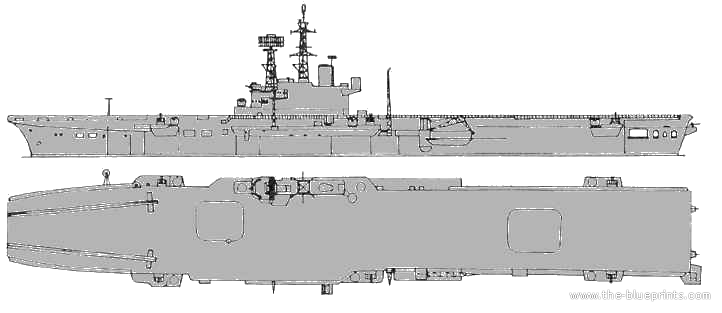
HMS Centaur was the only one completed to the original design, ordered from Harland & Wolff on 12 July 1943, laid down on 30 May 1944. Her construction was halted for two years amidst budgetary discussions and concessions, redesign. Eventually she was completed on 1 September 1953 on a modified variant of the second 1947 design. She was commissioned on 17 September with the interim 5.5-degree angled deck fitted at Portsmouth from October 1953 to May 1954.
She had limited modernization refit from September 1956 to September 1958 (new BS-4 steam catapults) to operate modern jets but not the full angled flight deck due to unsufficient yard capacity. Due to this, she was limited to operate the Sea Vixen and Fairey Gannet.
After being converted as an helicopter assault ship she helped suppress the Tanganyika Rifles in 1964. She was the first to leave service, decommissioned on 27 September 1965, accommodation ship for the remainder, with plans to convert her fully as an helicopter carrier cancelled in 1966. She was sold on August 1972.
HMS Albion (R07)
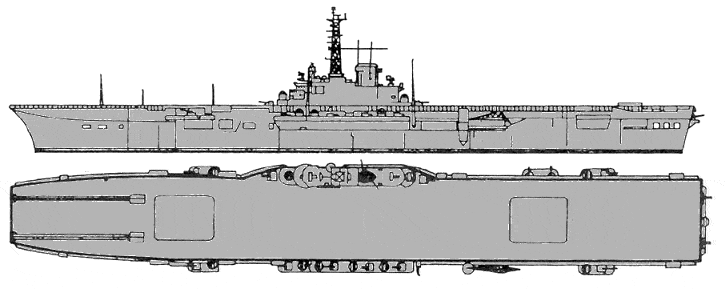
HMS Albion was ordered from Swan Hunter on 12 July 1943, Wallsend-on-Tyne, laid down on 23 March 1944 so muxh later than her sister. Work slowed down after 1945 until suspension on V-Day. The hull was eventually launched on 6 May 1947 as her redesign was just approved, laid-up for a revised machinery to be installed, and completion resumed after August 1949, with more years until completion, and eventual commission on 26 May 1954. She was completed with the interim 5.5° angled flight deck but also the new mirror landing aids.
To her credit she took part in Operation Musketeer (Suez Crisis, 1956) but later her planned modernizion (new steam catapults, fully angled deck) was cancelled after the 1957 defence policy review. She was instead converted into a helicopter assault ship at Portsmouth Dockyard until July 1962 and had more refined accomodation than Bulwark, enabling her to carry 900 troops, so much so that her sister was later refitted to the same standard. The 1973 defence review cancel the new planned refit, the budget reaffected for the constructon of the more modern HMS Invincible (R05). Decommissioned on 2 March 1973 she was sold on 22 October 1973, she was to be converted into a heavy-lift crane for the North Sea oil industry but the plan never materialized.
HMS Bulwark (R08)
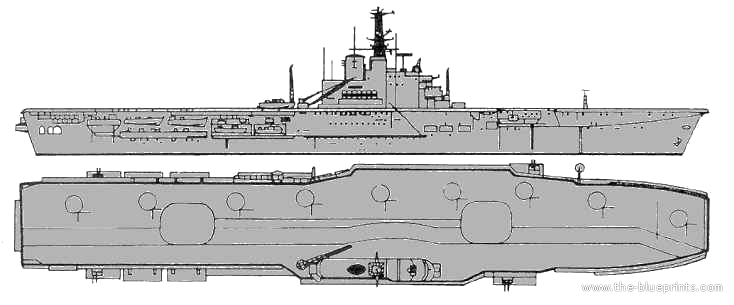
HMS Bulwark was ordered from Harland & Wolff on 12 July 1943, deferred in early 1944, laid down on 10 May 1945, as fourth ship of the class (instead of Monmouth, Fairfield) and construction slowed postwar. She was indeed eventually commissioned on 29 October 1954, still completed with the interim 5.5-degree angled flight deck, on 4 November. She became a trials and training carrier in 1955-1956 in place of the discarded HMS Illustrious. She was back in action by August 1956 for Operation Musketeer, Suez Crisis. The 1957 defence policy review had her repurposed and rebuilt as an helicopter assault shipe at Portsmouth Dockyard (January 1959-January 1960) and 1963 as Albion standard. By June 1968, she took part with her sister with a large landing exercize in Norway (NATO Exercise Polar Express).
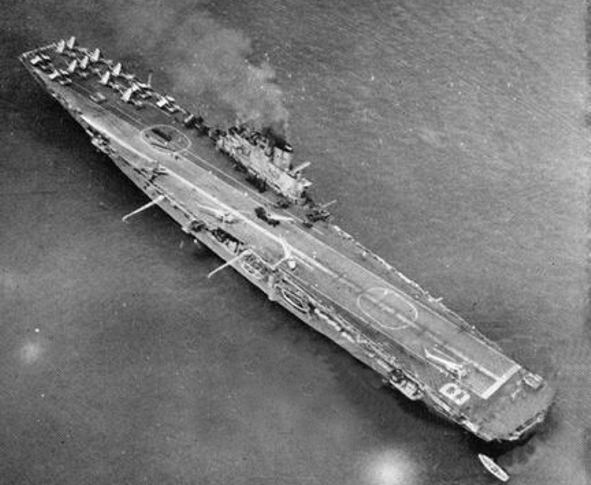
HMS Bulwark at Anchor, May 1958
In reserve by April 1976, she was reactivated to replaced in 1978 HMS Ark Royal (R09) retired earlier for replacement. Thus, unlike her sisters, she was refitted in 1977-1979, back in full service with modern jets on 23 February 1979. However she suffered a boiler room fire in March 1980 and was never fully repaired, then anither major fire. This time, combined with her age and general poor material state, led to her decommissioned six months in advance on 27 March 1981. The Royal Marines used her hull for exaercizes for years but plans to convert her into an aircraft maintenance carrier for the Falklands War was rejected and she was sold for scrap by 1984.
Hermes ii (ex-Elephant, R12) and INS Viraat
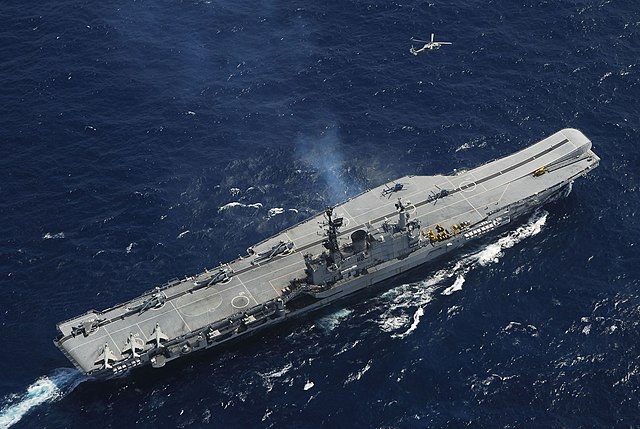
Detailed in a specific sub-part earlier, and in greater detail for her career later, see notes.
Arrogant
HMS Arrogant was ordered from Swan Hunter on 12 July 1943, delayed to early 1944, cancelled on 15 October 1945 without work done at Wallsend-on-Tyne.
Monmouth
HMS Monmouth was ordered from Fairfield Shipbuilding & Engineering Co., 12 July 1943. Construction was scheduled to start in 1944 but Fairfield had no room for her so she replaced Monmouth in 1945 and was cancelled on 15 October without any work done.
Polyphemus
HMS Polyphemus ordered from Devonport on 11 August 1943 was to follow HMS Terrible and it was delayed utntil late 1943, but no keel was laid down, she was cancelled on 15 October 1945. Parsons Marine Engineering had orders for her machinery.
The Centaur class career
 HMS Albion 1954-1972
HMS Albion 1954-1972
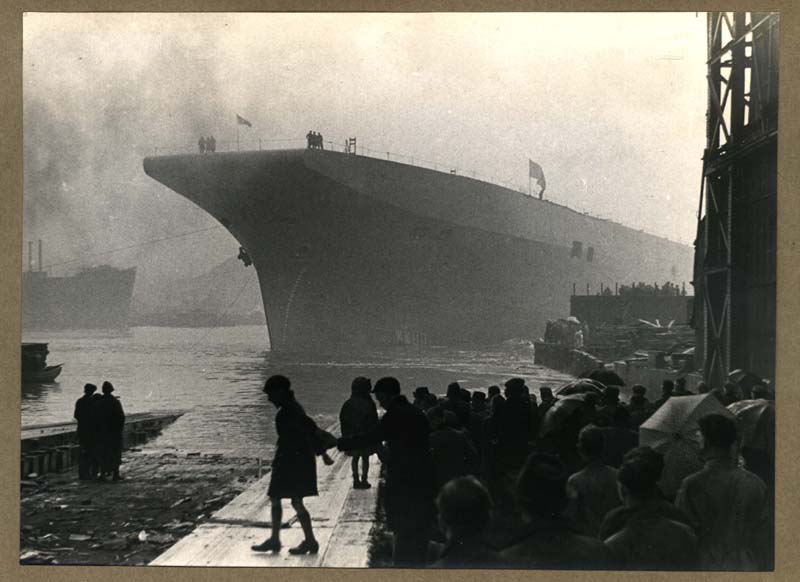
The launch of HMS Albion on the Tyne, 1947
HMS Albion when launched on 6 May 1947 was baptised by Violet Attlee, wife of PM Clement Attlee. On 18 October 1949 she was tugged from Jarrow to Rosyth and completion fitting out when colliding with SS Maystone, some 4 nautical miles (7.4 km) from the Longstone Lighthouse. Maystone sank, and Albion had a 225-square-foot (20.9 m2) stern gash to repair, taking some flooding. The three tugs attempted to beach her near St Abbs Head, one being disabled when a tow rope broke and wrapped around her propeller. HMS Restive, a much larger navy tug went Rosyth to assist as well as the destroyer HMS St James, eventually she berthed at Rosyth and completion slipped from to May 1954. In the night of 19–20 June 1954 she proceeded to helicopter qualifications, and thet immediately went into a first search mission for survivors of a splashed Swissair aircraft. When her air group was fully qualified she departed in September for the Mediterranean Fleet and became flagship in October for the Aircraft Carriers.
In 1956 she was refitted at Portsmouth and made a second Med TOD this time taking part Operation Musketeer (The Suez Crisis), her air group hitting Egyptian airfields and covered paratroopers. By July 1958, she carried also the 42 Commando Royal Marines to the Middle East.
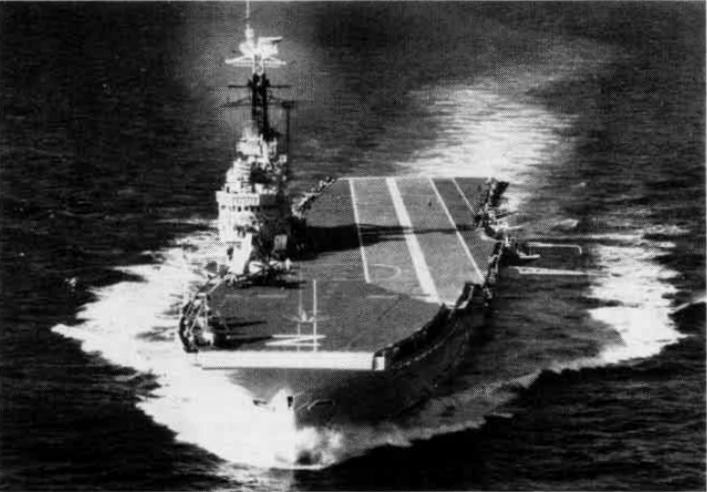
Albion underway in 1957
The next two years she operated in the Far East and to Australia, New Zealand, south Atlantic, Indian Oceans, then paid off in Portsmouth, considered as replacement for the Australian carrier HMAS Melbourne. By January 1961 she was converted as a commando carrier, following her sister Bulwark, recommissioned in 1962 and receiving 845 and 846 helicopter squadrons plus the 40 Commando Royal Marines, soon nicknamed the “The Old Grey Ghost of the Borneo Coast”. On 26 November 1962 she collided with a tug in Aden. She was the centerpiece of Borneo operations and with Indonesia. In 1967 she covered the withdrawal from Aden. In 1971 same from Singapore, witnessing the Far East Fleet disbanded.
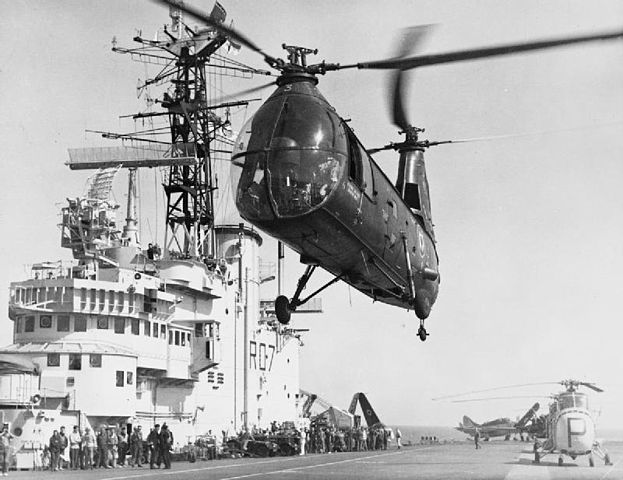
A French Piaesecki HUP lands on HMS Albion during in 1957
She left Portsmouth in March 1971 for the Far East (Captain James Jungius) stopping at Ascension Island on her way to Durban, April 1971, then Bombay 3-6 May 1971 and after seven weeks carried the 40 Commando Royal Marines off Changi for an exercise. She later made a ceremonial entry into Singapore, making a flyby from 848 NAS, disembarked to HMS Simbang. She carried the Australian Army Band and went to Japan, dodging typhoons on her way. In Kobe from 1 to 8 July 1971, she was back to Singapore followed by a night assault exercise in Marang.
In Fremantle on 9 August 1971 for visit she was back to Singapore on 23 August, departed again on 20 September, and ended at the U.S. Naval Base Subic Bay, then Hong Kong on 30 September alongside the British naval base tender HMS Tamar until 11 October.
From 15 October, she trained with the 40 Commando Royal Marines and 848 NAS for the final British withdrawal from the Far East with a farewell parade on 29 October in Sembawang, saling the 31th. Via Gan and Mombasa in November, a short self-maintenance period in Kilindini, she sailed to Masirah Island with the “Gulf Covering Force”, in the Persian Gulf. On 10 December she evacuated British citizens in the Bay of Bengal during the Indo-Pakistan War and was in Gan on 15 December. Back home on 5 January 1972 she disembarked 848 NAS, entered Portsmouth on the 24th for maintenance.

Sea Venom launched from Albion during Operation Musketeer
She departed on 11 April 1972 with 848 NAS again for the Mediterranean via Gibraltar, to Cyprus from 20 to 29 April in a Royal Marines exercise followed by NATO “Dawn Patrol”, stopping at Kavala and Souda Bay, then back home via Gibraltar, and official visit to Brest 23-30 May 1972 with CiC Admiral Sir Edward Ashmore. Back to Portsmouth fall May, she entered a short maintenance, and by June 1972 made demonstrations at sea for officers from the Royal College of Defence Studies. At Rosyth she was visited by the Grand Duke of Luxembourg. Now with the 45 Command Royal Marines and 848 NAS she trained from the Firth of Forth to the Orkney Islands. She visited Rotterdam 28 June-4 July and by 8 July 848 NAS left Albion for good. She sailed to take part in the Clyde Week in Greenock. After Dover she hosted the 18 July Families’ Day in Portsmouth, and went into maintenance.
In September 1972 she took part in the largest NATO Exercise so far, “Strong Express” in Norwegian waters. She sailed to Canada from Portsmouth on 10 October 1972 with 42 Commando Royal Marines and 845 NAS aboard, to Saint John, New Brunswick on 19 October, for exercises ashore with Canadian forces. She made a state visit to Halifax, hosted by HMCS Stadacona. Sailing the Saint Lawrence to Montreal later she embarked 150 Canadian sea cadets from Montreal to Quebec and returned on 10 November to Saint John, hosted back 42 Commando, departed on 15 November and bacl to Plymounth on 22 November, Albion anchored in Plymouth Sound and disembarked 42 Commando, 845 Naval Air Squadron and Kangaw Flight RM. Sailing from Plymouth the next day, she entered Portsmouth Harbour at 1430 on 24 November. She had a paying-off pennant, her planned retirement celebrated by a fly-past by 845 Naval Air Squadron. In 1973, stricken, she was sold for conversion to a heavy lift vessel but this was cancelled and she was BU.
 HMS Bulwark 1954-1984
HMS Bulwark 1954-1984
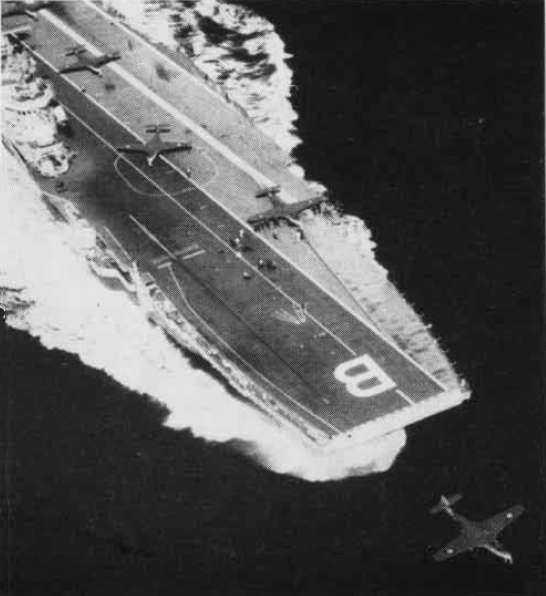
Sea Hawks launching from Bulwark in 1956
Sixth of the name, HMS Bulwark was delayed commissioned to 4 November 1954. In 1956, after training, shakedown, crew and pilot’s qualificatiions, HMS Bulwark took part in the Suez Crisis Operations: She launched up to 600 sorties. On 13 September 1958 in the Gulf of Oman she assisted the tankers SS Melika and Fernand Gilabe which collided and caught fire. Her helicopters landing fire fighting parties. She towed Melika to Muscat and one her Whirlwind 845 NAS was awarded the Boyd Trophy.
The same year when back she was paid off at Portsmouth for conversion into a commando carrier, the first of the kind, recommissioned with 42 Commando Royal Marines, 848 Squadron aboard. By 1961 there was already a threat of invasion of Kuwait by Iraq and she landed 42 Commando here as deterrent. She was commissioned Singapore after her conversion, took part in Indonesian Confrontation. June 1966 she hosted the flight debuts of the VTOL Hawker Kestrel prototype of the Harrier. By 1967 she was back in Singapore Naval Dockyard for maintenance, and relieved Albion, nicknamed “The Rusty B”.
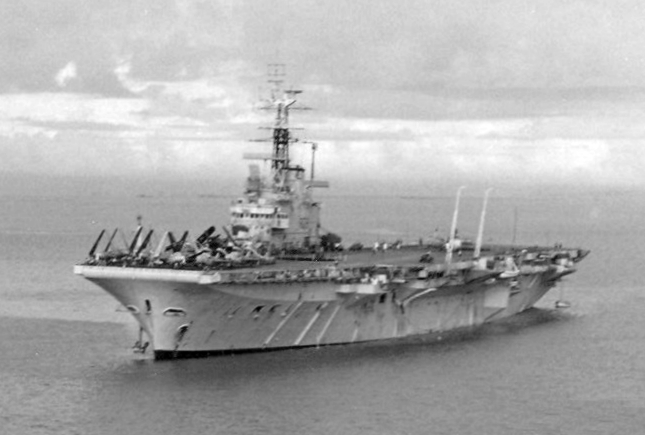
Bulwark in Singapore, 1958
In 1968, she saw exercizes in the Arctic with 45 Commando (Polar Express) and was drydocked in Portsmouth for a major refit. By May 1969 under Captain J.A. Templeton-Cotill she sailed for the Mediterranean and NATO “Olympic Express” in the Aegean. She stopped at Gibraltar, Malta, Cyprus, Salonica, Venice, Villefranche, and Toulon on her way in both directions, and hosted a TV crew for the ‘Captain R.N.’ documentaty. Back to Devonport she had another 4 months refit from August 1969. January 1970 saw her sailing to Singapore via Gibraltar and Cape Town. She was repaired in Singapore NyD after damage due to the Storm Diane and sailed for Kobe for EXPO 70. Later she stopped at Hong Kong, Jakarta, Perth and back to Plymouth, Liverpool in July 1971.
In September she took part in Mediettarean exercises with 845 NAS but while off Trieste, suffered a boiler room fire. Repaired in Plymouth she returned to Malta for Operation Exit in January-March 1972.
In 1972 she took part in other withdrawals like her sister Albion, and became HQ for Operation Exit (withdrawal from Malta), an exercises in the Caribbean Sea, visit to Florida with 845 Squadron. Back to Plymouth she was dry docked for maintenance until January 1973 followed by new exercises in the Caribbean, damage due to heavy storms, stopping at Charleston, largest warship ever under the Cooper Bridge. Later she weathered a snow storm and returned in Caribbean, stopping at Viaques and Puerto Rico. Under Captain Derek Bazalgette she was back in the Mediterranean in 1973 (Malta, Piraeus, Istanbul, Gibraltar, Travemünde, Lübeck). She trained in 1975 with the Netherlands Marine Corps in the Dutch Caribbean and weathered this year’s storms. This was followed by the 1974 refit in Devonport and back to the Mediterranean and back to Plymouth in July 1975.
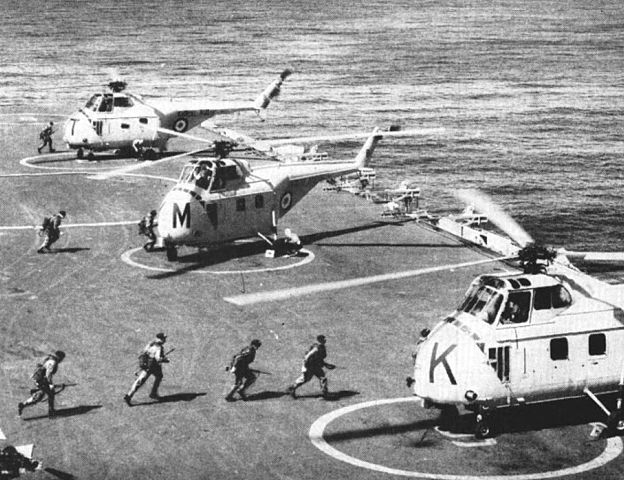
Westland Whirlwinds heating up for action with Royal Marines rushing in on Bulwark as commando carrier, 1961.
In March 1976 she was placed in Reserve with dicussioned by the MoD to sell her to the Peruvian Navy but it went to nil after two years of negotiations. She had a last refit at Portsmouth in 1978, recommissioned as ASW carrier, on 23 February 1979. By 28 June she took part in exercise Whiskey Venture with Sea Kings of 820 NAS, 45 Royal Marine Commando. She hosted also the first trials of the Sea Harrier. It was discovered the use of a ski ramp would allow it to take off with greater payloads. In early 1980 she was in the US east coast for Exercise Safe Passage in February. On 15 March she had another boiler fire while berthed in Philadelphia and was back to Portsmouth on 2 April. On the 15th she sailed with 45 Commando for Exercise Dawn Patrol off Sardinia. In August she took part in NATO Teamwork 80 off Norway. On 9 November she had another major fire which wrecked the forward hangar, messdecks but had only small repairs just to stay in service until the commission of HMS Invincible in 1981.
By 27 March 1981 she was decommissioned in portsmouth, but kept in unmaintained reserve, unrepaired, for two years. During the Falklands episode the MoD announced she was to be reactivated but a rapid ship survey and absence of repairs meant a considerable budget was needed, which was denied, and she was disposed of in April 1983, kept for cannibalization for Hermes, anchored until towed to Cairnryan and BU by April 1984.
 HMS Centaur 1953-1971
HMS Centaur 1953-1971
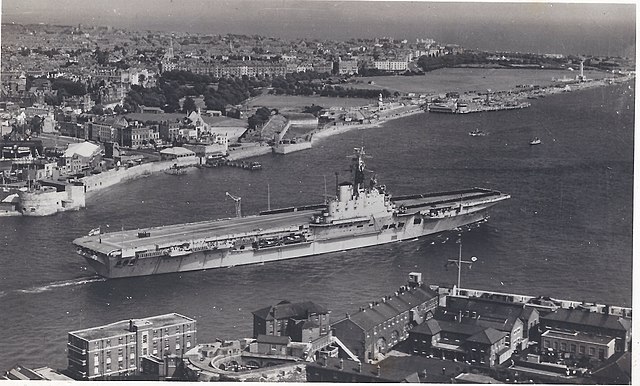
HMS Centaur leaving Portsmouth as completed
HMS Centaur was completed and started the contractor’s sea trials by March 1953, eventually commissioned on 17 September 1953 with final sea and machinery trials in October, then fixes at Portsmouth Dockyard and her final 5.5° angled deck and she lef Portsmouth on July 19 1954 for the Mediterranean under Captain H.P.Sears and later Captain H.C.F Rolfe plus an initial air group of 25 aircraft from July 1954.
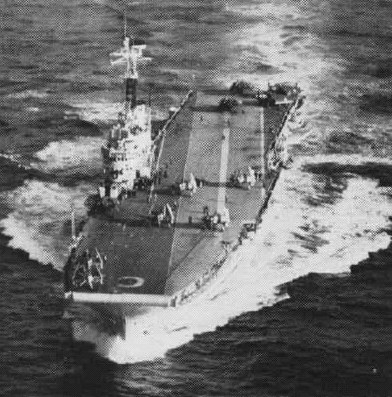 Her four months completed she was to leave Suez to relieve HMS Warrior in the Far East, but remained until June 1955. She trained with Albion and NATO and took part in British withdrawal from Trieste (October 1954), escorted royal yacht Britannia and make numerous friendly ports visits. Malta by February 1955 saw her 810 NAS Sea Furys disembarked, the squadron later disbanded in UK, replaced by nine Sea Hawks (803 NAS) flew on her deck from Albion in March 1955. She als traded her Avenger AS4s (820 Sqn) for six Avenger AS5s (814 NAS).
Her four months completed she was to leave Suez to relieve HMS Warrior in the Far East, but remained until June 1955. She trained with Albion and NATO and took part in British withdrawal from Trieste (October 1954), escorted royal yacht Britannia and make numerous friendly ports visits. Malta by February 1955 saw her 810 NAS Sea Furys disembarked, the squadron later disbanded in UK, replaced by nine Sea Hawks (803 NAS) flew on her deck from Albion in March 1955. She als traded her Avenger AS4s (820 Sqn) for six Avenger AS5s (814 NAS).
From June 1955 until January 1956 she spent the time in poets visits and exercises followed by 2 months maintenance in Portsmouth and she sailed for the Far East on 10 January 1956 with her sister Albion. She had a re-formed 820 Squadron (6 Fairey Gannet AS4s instead of Avengers). On her way she stopped in Aden for an exercize with RAF Venoms from Khormaksar, visited India, making flying demonstrations for the Indian government, interested to acquired an aircraft carrier, later leading to the purchase of HMS Hercules completed as INS Vikrant. AAfter Indian Ocean exercises, she sailed to Hong Kong and Singapore and back via Suez and Malta on 15 May 1956.

Centaur in the Mediterranean c1960
At the time, the MoD official polocy was to keep a fleet of four active aircraft carriers to meet NATO and Imperial commitments, so in reality 5-6 given the inevitable refits and modernisations. However the pace of naval aviation technology meant heavier 2nd-generation jet fighters (Supermarine Scimitar, De Havilland Sea Vixen) were harder to operate, apart HMS Ark Royal completed in 1955 and the rebuilt Victorious of one sister, HMS Hermes to join the fleet in 1958-1959, followed by the reconstruction of HMS Eagle in 1959-1964and next, Ark Royal. So for 5 years only 3 carriers were available and thus the Admiralty looked for an interim solution. Conversion of the small Centaur-class was difficult as all their specs were dating back 1943. Instead June 1956 to August 1958, saw Centaur undergoing a partial modernisation at Devonport. She was recommissioned on 3 September 1958 (Captain Horace Law) followed by post-refit ship trials and receiving and qualifiying her new air group (Sea Vixens, Scimitars, Gannet AEW3s).
In January-March she she was based in Malta and took part in the North Atlantic Exercise Dawn Breeze IV with HMS Eagle and newly re-commissioned HMS Victorious. By March her Whirlwind helicopters were landed due to unreliable engines, Dragonflies replacing them for SAR and plane guard duties. Six Gannet AS4s from June 1959 added a substantial ASW upgrade compared to the Skyraiders.
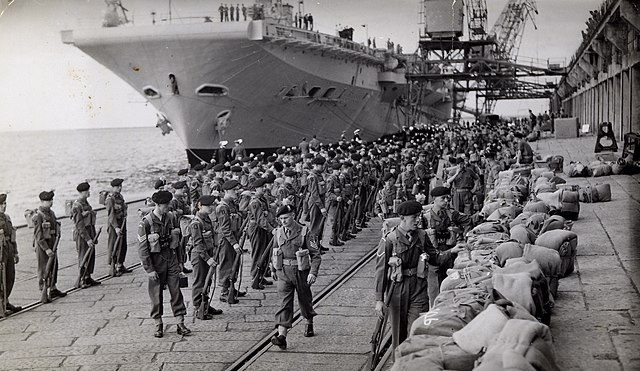
Troops embarking on Centaur at Trieste
In April 1959, Centaur she starred on “Sink the Bismarck!” impersonating both Victorious and Ark Royal, and hosting three surviving Fairey Swordfish biplanes, just restored. After home waters flying operations, visits to Copenhagen, Brest, she sailed for the Mediterranean via Lisbon and Gibraltar, disembarking Skyraiders from 849D NAS for Gannets of 810 NAS. After crossing the Suez Canal in June she went into the Indian Ocean and red sea (Kuwait, Aden, Trincomalee, visited there by PM Solomon Bandaranaike). After maintenance in Singapore she entered the Pacific or 3.5 months, trained with USS Lexington off the Philippines, visited Australia. After East Africa, she was back home, replaced in Suez by Albion. She started a refit in Devonport on 26 April (80,916 nautical miles, 7,805 catapult launches, loosing one Sea Hawk, two Sea Venoms and a Dragonfly).
From March 1961 she received her upgraded arrestor wires, new air-conditioning units and under Captain J.A.C.Henley she underwent sea-trials off Portland, qualified her new air group in April (8 Scimitar F1, 807, 9 Sea Vixen FAW1 893, 4 Fairey Gannet AEW3 849, 8 Whirlwind HAS7 824); and by April she was back in the Mediterranean, trained with Hermes and stayed due to the war in the Middle East when by June President Abd al-Karim Qasim of Iraq tried to annex Kuwait, with the latter asking for help from UK and Saudi Arabia. Operation Vantage was a deterrent, with Victorious TG sent there, then Bulwark landed Royal Marines at Kuwait airport and Centaur arrived from Malta to relieve Victorious. Pdt. Qasim was mater killed in a coup.
Centaur returned off Aden and Devonport in September for maintenance, returned to the Mediterranean and Indian Ocean, relieve Victorious East of Suez, visited Mombasa, Aden, Singapore and Hong Kong. She took part in the flood relief in Kenya. By May 1962 she had a new maintenance in Portsmouth seeing 807 squadron disbanded (she was to have the Blackburn Buccaneer but could not operate them, and had twelve Sea Vixens instead).
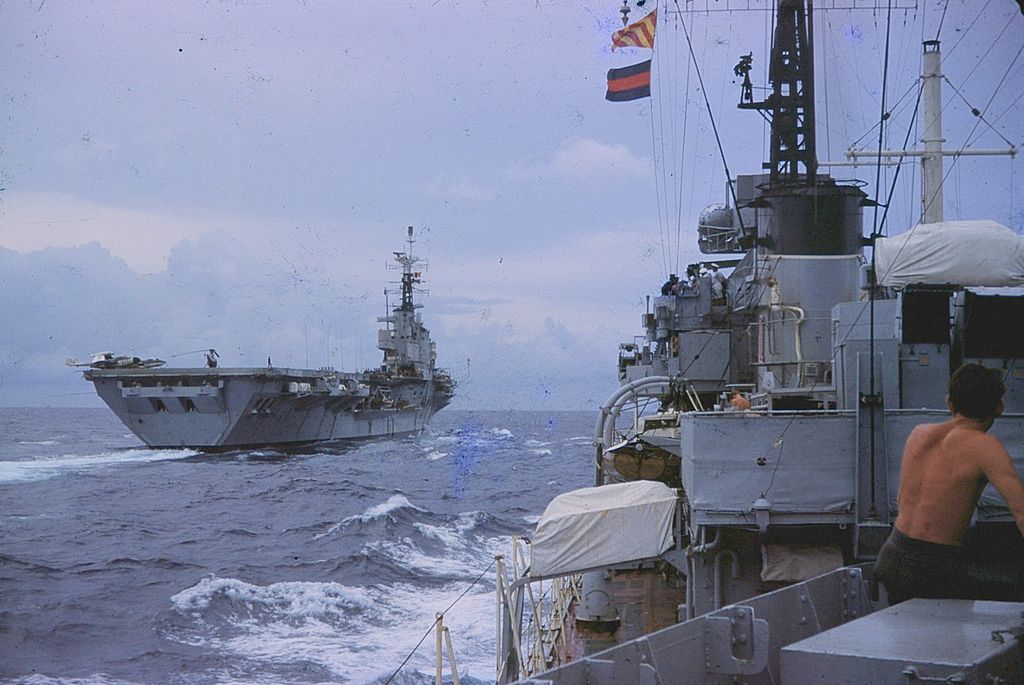
Ceylon to Aden transit, Centaur seen from D70.
Under Captain Philip G Sharp in 1962 she took part in exercises in the North Sea and Mediterranean, back in October. On 19 November in Irish Sea “A” Boiler lost pressure, speed drop to her port engine and this create issues with lighting and radar circuits due to the burst of a main steam-pipe, klling five crew members. She was repaired in Portsmouth on 27 November until 22 January.
After Channel training, loosing a Sea Vixen of 893 NAS she took part in an emergency relief in Wales and Northern Ireland after severe blizzards. By February 1963 she joined Hermes for cover at Suez, supporting loyal forces to the Sultan of Brunei after the Indonesian-backed revolt (Indonesian confrontation). She was in the gulf after the February coup in Iraq and back in Portsmouth on 22 May.
Speculation about a convertion to a Commando Carrier was however overruled to keep two carriers availabl east of Suez with their fixed-wing group. Refitted in Portsmouth June-November 1963 (new large Mirror Landing Sight fitted, Type 965 air search rada on lattice, better air-conditioning units and renewed Operations Room). In October she had to repair bow damage after a collision with the sub HMS Porpoise, caught by the ebb tide. Fully re-commissioned on 15 November 1963 (Captain O.H.M. St John Steiner) she embarked her final 22 aircraft air-group (12 Sea Vixen FAW1 892, 4 Gannet AEW3 849, 1 Whirlwind). Sometimes she also operated Scimitars from other squadrons. Intended for the Far East, she assist the Greek Cruise Liner TSMS Lakonia in fire off Madeira. She arrived off Aden in January, embarked six Wessex helicopters (815 Squadron NAS, RAF Khormaksar) for air support in Operations Damon and Operation Nutcracker, to put down the rebellion in the Radfan region.
In January 1964 the 1st Tanganyika Rifles at Dar-es-Salaam mutinied against their British officers and after a call from President Julius Nyerere, Centaur with 815 NAS helicopters and 45 Commando of the Royal Marines sailed to Dar-es-Salaam, the Marines landing on a football field near the barracks of the mutineers, assaulted, plus rounding up the rebels helped by four Sea Vixens. The crew was later invited for a parade in the streets of Tanganyika. HMS Centaur left on 29 January for the South China Sea, 3 months there, acted of presence of Singapore to deter the Indonesians as the new Malaysian Federation was just proclaimed. She was back later to Aden dealing with the Radfan rebellion, including air strikes against rebels of Radfan. On 26 July she took part in FOTEX 64 i the South China Seas with HMAS Melbourne later for Exercise Stopwatch. She was also involved in the Indonesian Confrontation this summer, when Indonesian troops captured Labis, Centaur took station to bar further incursions until 25 November and back home for Xmas.
After a new refit until March 1965, it was announced her early withdrawal. She was to make a last deployment to the Mediterranean in April-June and many port visits and exercises. She was also closely shadowed by the Soviet Black Sea Fleet. In July back home she made a last round of farewell visits and Royal Review in the Clyde by August. In Portsmouth she was open for visits at Navy Days, paid off on 27 September 1965. Budgetary constraints readicated any moderniation, nor conversion as Commando Carrier but her accomodatiions were valuable and she was used as such for the crew of HMS Victorious under refit. In 1966 she was towed to Devonport this time for HMS Eagle. In 1967 she became a tender to RN Barracks HMS Drake at Devonport and in Portsmouth, accommodation ship for Hermes during her refit. In 1970 she returned to Devonport, for the same, but after a survey she was put on the disposal list, sold on 11 August 1972, towed to Cairnryan for BU.
 HMS Hermes 1959-1987
HMS Hermes 1959-1987
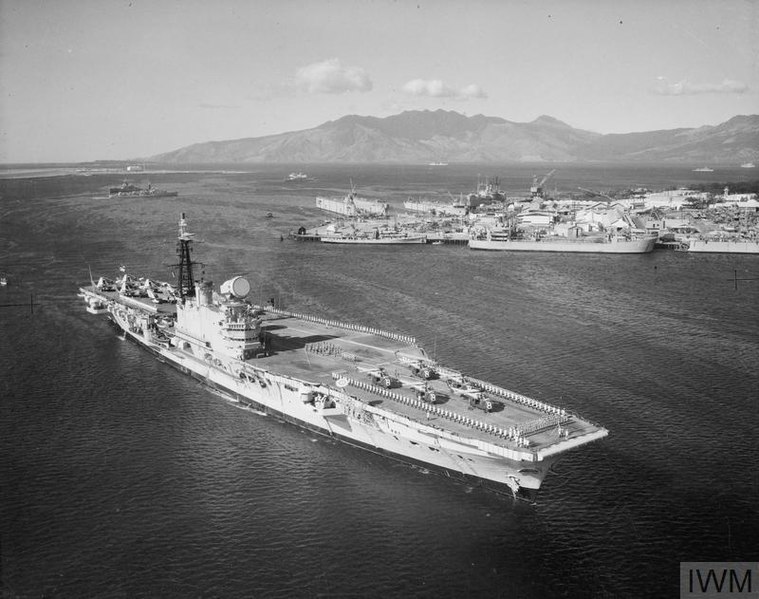
HMS Hermes in Subic Bay, Philippines, 18 January 1961
HMS Hermes entered service after being renamed from HMS Elephant, seeing her construction suspended in 1945, resumed in 1952 only to clear the slipway. She returned on it for her hull was launched on 16 February 1953, not completed before 1957 and only commissioned by 18 November 1959 after extensive modifications which brought her on the same level as the rebuilt HMS Victorious. She differed completely from the rest of the class already, and this was just the start. For this first completion, cost has been £18 million, plus £1 million for the electronics, £10 million for her initial air park. Hermes could indeed operate the Scimitar, Sea Vixen, Gannet and Whirlwind helicopters, a similar air group than her sisters.
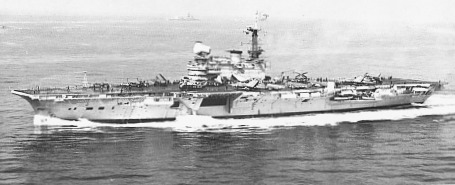
Hermes in 1967
After the usual shakedown, initial training, post-fixes, advanced training and air group qualifications in 1960-61 she was at last ready on 16 November 1962, training off Wales when one of her Whilwind helicopters carrying Lord Windlesham and John Cronin crashing when back from the carrier off St David’s Head. Cronin as the crew survived.
At the same time, John Hay, Civil Lord of the Admiralty, announced in Parliament on 2 March 1964 to change the air group and include her with a full squadron of Mach 2 F-4B Phantoms. Tests started in 1963 already. He proposed also “Hermes” and “Eagle” for this. The Admiralty however argued that Hermes needed a comprehensive modernisation to operate the Phantom and eventually it was ruled out due to her small size.
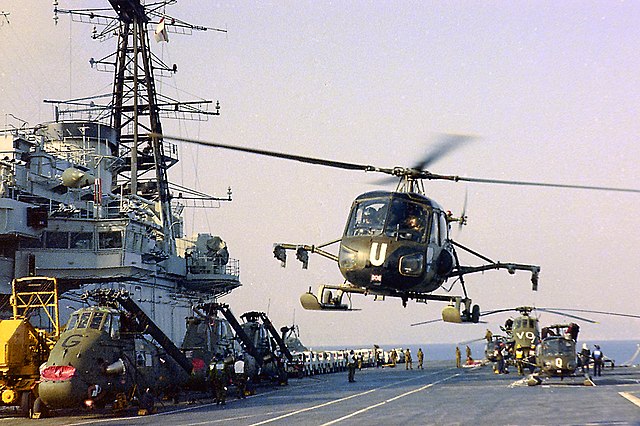
Westland scout landing on Hermes
Too small to operate the F4 Phantom
However it was still optimistically believed that she could replace its Vixens with Spey-powered Phantoms, so circa 11–12 of these complemented by 7–8 Blackburn Buccaneer, and McDonnell worked hard to have these tailored for British use, as Vought have done for the French F8FN Crusaders of the Clemenceau class. Indeed measures were taken to improve deceleration on landing, and tests were made, which were not successful. Hermes unlike the other fleet carrires was way too short, making any landing hazardous, between weak arresting gear and catapults, even with the lighter F-4Ks. Thes Phantom trials went on intensively between 1969 and 1970 and met relative success, proving the possibility. MoD Denis Healey however feared these would be in too small numbers to be effective. Hermes in the end was not seen as a viable substitute for CVA02 planned at the time, and the programme ran into budgetary cuts in the end.
The Australian Deal
Being too small to be really effective, the government considered selling her to Australia, still waiting for a replacement for HMAS Melbourne. In 1968, testing the watersn the RN sent Hermes for combined exercise with the RAN, and she was visited by senior RAN officers and government officials. The carrier flew and retrieved also RAN Douglas A-4G Skyhawks and Grumman S-2 Trackers. But the proposal was in the end turned down for higher operating costs than Majestic ships.
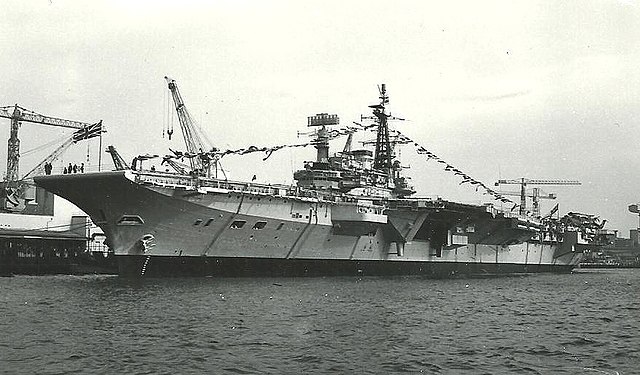
Hermes in the 1960s
Hermes was nevertheless in the 1960s the mist capable of the Centaur class, and at the same time, integrated as the four Royal Navy strike carriers rotating in the Indian Ocean and Mediterranean. Compared to the later upgraded Hermese, Eagle and Victorious, she was however the smallest and leat capable and decommission was planned already for 1970. As Egypt closed off the Straits of Tiran to Israeli shipping in May 1967, both UK and US planned an intervention, but the British government backed down and Hermes was not included in these operations.
However if in her main romle, she was undone by her now obsolete 1st gen jets park, she could have been converted as a commando or ASW carrier.
Hermes as ASW/Commando carrier
In 1965 it was at last decided to phase out Hermes’ fixed wing group. It seemed more profitable to make at the time of the four Centaurs, rotating “Commando Carriers” (ensuring at least two were available at all times), to project the Royal Marines the same way the USN operated its LHA. Agreed, these carriers had no facilities for carrying and launching landing crafts, albeit small ones in davits, but they still could operate a relatively large rotary wing group. Since ASW platforms were needed, this was stated as second role. Hermes based on this was drydocked in Devonport between 1971 and 1973.
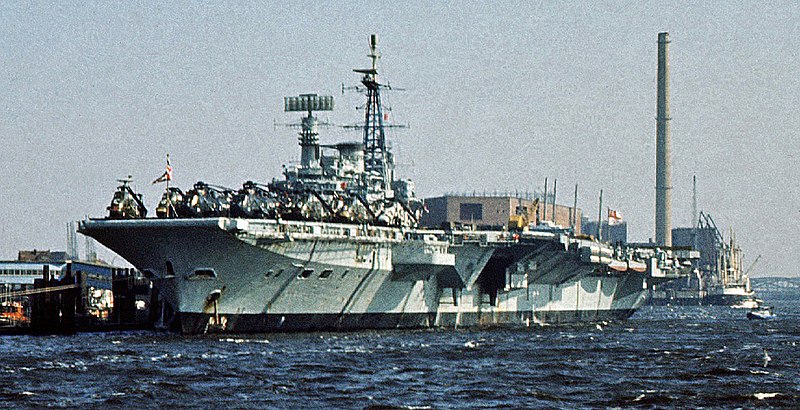
Hermes in Hamburg, 1974
This conversion was still radical, seeing the removal of her arresting cables, steam catapults, 3-D radar while she was modified to carry under davits several Landing craft, while providing accomodations for some 800. The airwing was standardized to 20 Westland Sea King helicopters, larger than any previous models. They could both carry troops and operate as ASW hunters, making her a dual role (ASW and assault) carrier. In 1976 indeed the Soviet submarine threat was very real with dozens of SSNs, SSGNs and new SSBNs, and under NATO pressure, Hermes was turned into anti-submarine warfare carrier, intended to do its duty in the North Atlantic. It was urgent as the only carrier that filled that role until then in Europe, HNLMS Karel Doorman, had been sold to Argentina in 1966. Hermes operated thus a short time as ASW/Commando carrier, in the idea her normal role would the first, and second in special operations only.
Hermes as VTOL carrier
Her last conversion started at Portsmouth, from 1980 to June 1981. She kept her previous modifications, with more modern radars, but gained this time a 12° ski-jump and facilities to operating the BAe Sea Harrier. This ensured the return of a fixed-wing park, something appreciated as the Invincible class program was delayed and Eagle, Ark Royal and Victorious, the three main fleet carriers were retired as per the gloomy 1981 Defence Review, whereas the PL02 program was now cancelled for good. At first this park was still “ASW oriented”, with 12 Sea Kings and only 5 5 Sea Harrier FRS.1 fighters.
Falklands War:
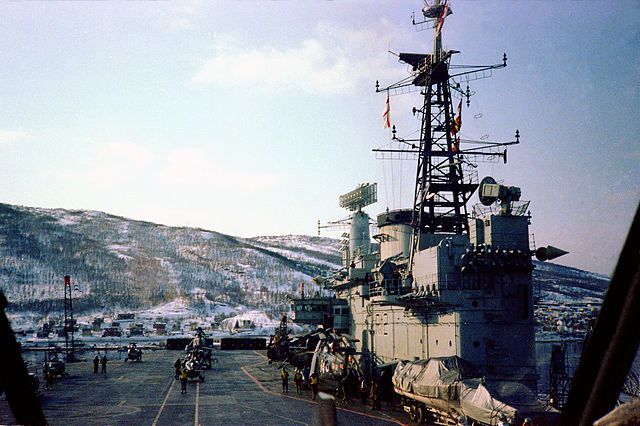
Hermes as commando carrier in freezing northern Norwegian waters. Similar conditions were met in the Falklands.
This was short, as Hermes, due to decommissioned in 1982 was saved by the Falklands War. She was prepared for extensive operations, including C3 to act as flagship for the British forces deployed in the South Atlantic, prepared in record time to depart a mer few days after the Argentine invasion. This time she had 12 Sea Harrier FRS1 and 18 Sea King helicopters. More aircraft were flown in/transported to replace losses and at the heart of the war, she had 16 Sea Harriers, 10 Harrier GR3s RAF, 10 Sea Kings, the remainder dispersed to other ships. The ones she kept were tailored to operate the Special Air Service (SAS) and Royal Marines. She stayed afr under good escort however, aware of the risk in having her too close to the Falklands. This was an issue as the Harriers flew at the limit of their (short) endurance.
Last years, post-Falklands
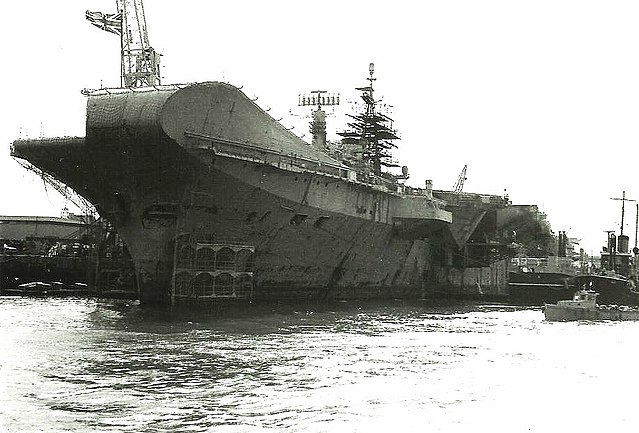
Post-Falklands Overhaul
Hermes made a historical comeback to crowds cheering, and after some public opening, was sent straight to the drydock for a much needed 4-month refit, all networks as well as cleaning and repainting. The South Atlantic waters and constant operations there has not been tender to the WW2 carrier… When out in November 1982, she started a serie of exercises in the North Atlantic, reverting to her ASW role, but also in the Mediterranean as commando carrier. By late 1983 she took part Ocean Safari, as strike carrier with 12 Sea Harriers, 10 RAF Harrier GR.3s, 10 Sea Kings like in the Falklands. She had a last refit at Devonport but ended in reserve in Portsmouth.
In 1983, the government considered the recent HMS Invincible to be sold to the Royal Australian Navy, before the Falklands War, and instead Hermes was proposed, along with a squadron of Sea Harriers, after all, “battle proven”. The Hawke government however ruled this out and decided to retire HMAS Melbourne without replacement.
Hermes stayed in active service until 12 April 1984, and stayed from then in Portsmouth with nucleus crew with the White Ensign. By April 1986 she was towed to Devonport for a last refit. This time a protracted deal with india has been signed. She was modernized and transferred to India, starting a new 30 years career as INS Viraat, from 1987 to 2017.
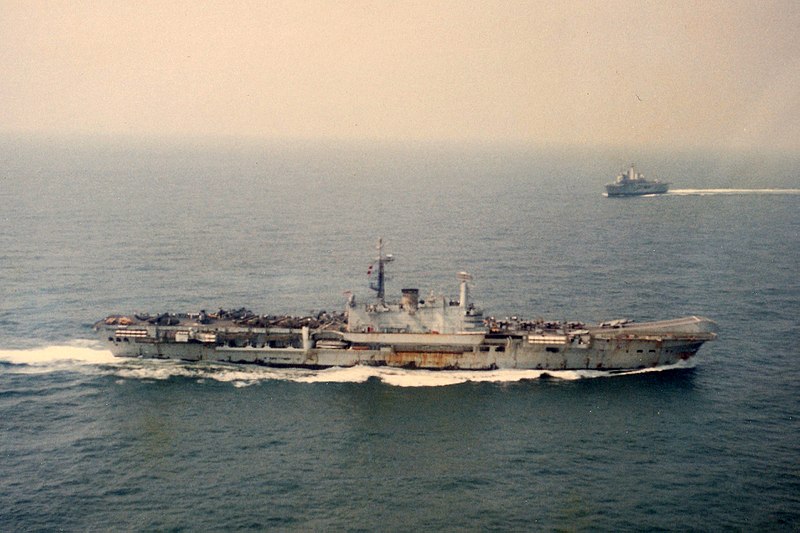
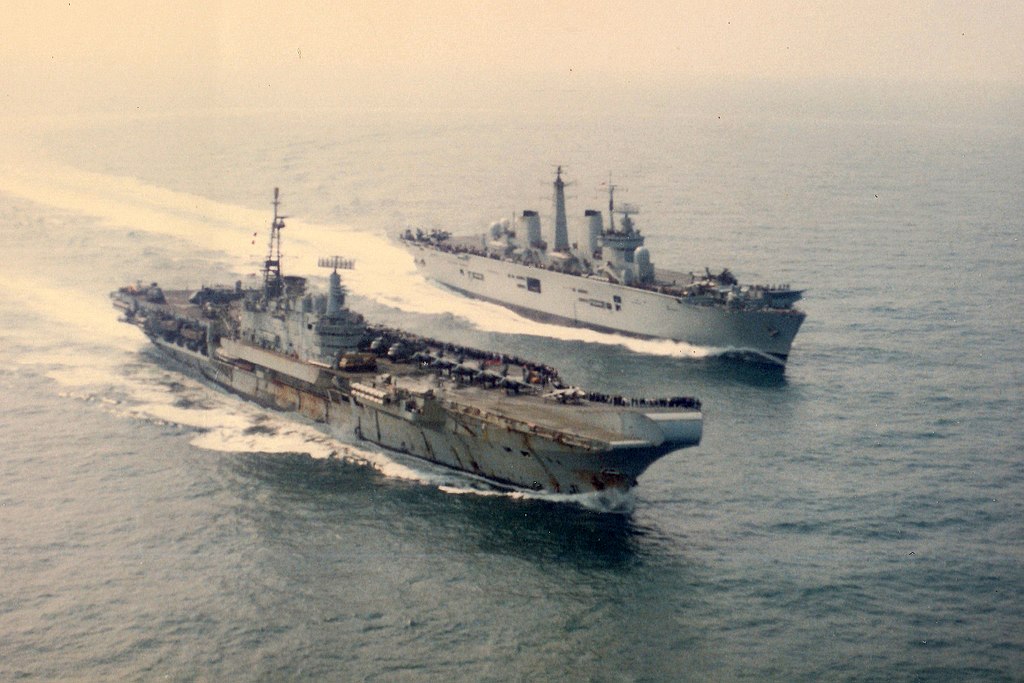
Hermes and Illustrious in the Channel on 20 July 1982
After her retirement, there were proposals to have her preserved. This became a British crowdfunding campaign aiming at £100,000, but ending at £9,303, and eventually cancelled. However perhape because of the British motivations, the Maharashtra cabinet approved in late 2018 her conversion as the firsr RIN moored maritime museum, doubling as marine adventure centre, at Nivati, Sindhudurg. By 1 July 2019 the Indian MoD informed the Parliament unfortunately the lack of financially self-sustaining proposal forced to declined the proposal. So she was sold to a ship breaker in Alang, starting in December 2020. It was put on hold in 2021 with another proposal to turn her as museum ship, but since she was 40% demolished at that point, this was turned down. As of late 2023 it is very likely she is no more.


 Latest Facebook Entry -
Latest Facebook Entry -  X(Tweeter) Naval Encyclopedia's deck archive
X(Tweeter) Naval Encyclopedia's deck archive Instagram (@navalencyc)
Instagram (@navalencyc)





 French Navy
French Navy Royal Navy
Royal Navy Russian Navy
Russian Navy Armada Espanola
Armada Espanola Austrian Navy
Austrian Navy K.u.K. Kriegsmarine
K.u.K. Kriegsmarine Dansk Marine
Dansk Marine Nautiko Hellenon
Nautiko Hellenon Koninklije Marine 1870
Koninklije Marine 1870 Marinha do Brasil
Marinha do Brasil Osmanlı Donanması
Osmanlı Donanması Marina Do Peru
Marina Do Peru Marinha do Portugal
Marinha do Portugal Regia Marina 1870
Regia Marina 1870 Nihhon Kaigun 1870
Nihhon Kaigun 1870 Preußische Marine 1870
Preußische Marine 1870 Russkiy Flot 1870
Russkiy Flot 1870 Svenska marinen
Svenska marinen Søværnet
Søværnet Union Navy
Union Navy Confederate Navy
Confederate Navy Armada de Argentina
Armada de Argentina Imperial Chinese Navy
Imperial Chinese Navy Marinha do Portugal
Marinha do Portugal Mexico
Mexico Kaiserliche Marine
Kaiserliche Marine 1898 US Navy
1898 US Navy Sovietskiy Flot
Sovietskiy Flot Royal Canadian Navy
Royal Canadian Navy Royal Australian Navy
Royal Australian Navy RNZN Fleet
RNZN Fleet Chinese Navy 1937
Chinese Navy 1937 Kriegsmarine
Kriegsmarine Chilean Navy
Chilean Navy Danish Navy
Danish Navy Finnish Navy
Finnish Navy Hellenic Navy
Hellenic Navy Polish Navy
Polish Navy Romanian Navy
Romanian Navy Turkish Navy
Turkish Navy Royal Yugoslav Navy
Royal Yugoslav Navy Royal Thai Navy
Royal Thai Navy Minor Navies
Minor Navies Albania
Albania Austria
Austria Belgium
Belgium Columbia
Columbia Costa Rica
Costa Rica Cuba
Cuba Czechoslovakia
Czechoslovakia Dominican Republic
Dominican Republic Haiti
Haiti Hungary
Hungary Honduras
Honduras Estonia
Estonia Iceland
Iceland Eire
Eire Equador
Equador Iran
Iran Iraq
Iraq Latvia
Latvia Liberia
Liberia Lithuania
Lithuania Mandchukuo
Mandchukuo Morocco
Morocco Nicaragua
Nicaragua Persia
Persia San Salvador
San Salvador Sarawak
Sarawak Uruguay
Uruguay Venezuela
Venezuela Zanzibar
Zanzibar Warsaw Pact Navies
Warsaw Pact Navies Bulgaria
Bulgaria Hungary
Hungary

 Bundesmarine
Bundesmarine Dutch Navy
Dutch Navy Hellenic Navy
Hellenic Navy Marina Militare
Marina Militare Yugoslav Navy
Yugoslav Navy Chinese Navy
Chinese Navy Indian Navy
Indian Navy Indonesian Navy
Indonesian Navy JMSDF
JMSDF North Korean Navy
North Korean Navy Pakistani Navy
Pakistani Navy Philippines Navy
Philippines Navy ROKN
ROKN Rep. of Singapore Navy
Rep. of Singapore Navy Taiwanese Navy
Taiwanese Navy IDF Navy
IDF Navy Saudi Navy
Saudi Navy Royal New Zealand Navy
Royal New Zealand Navy Egyptian Navy
Egyptian Navy South African Navy
South African Navy






























 Ukrainian Navy
Ukrainian Navy dbodesign
dbodesign
Very impressive and informative information on the Centaur-class thank you.
I would love to know more of “The Australian Deal” of 1968.
Regards
Thanks ! Possibly when going back to Aussie carriers with Melbourne. Already had a go with sydney.